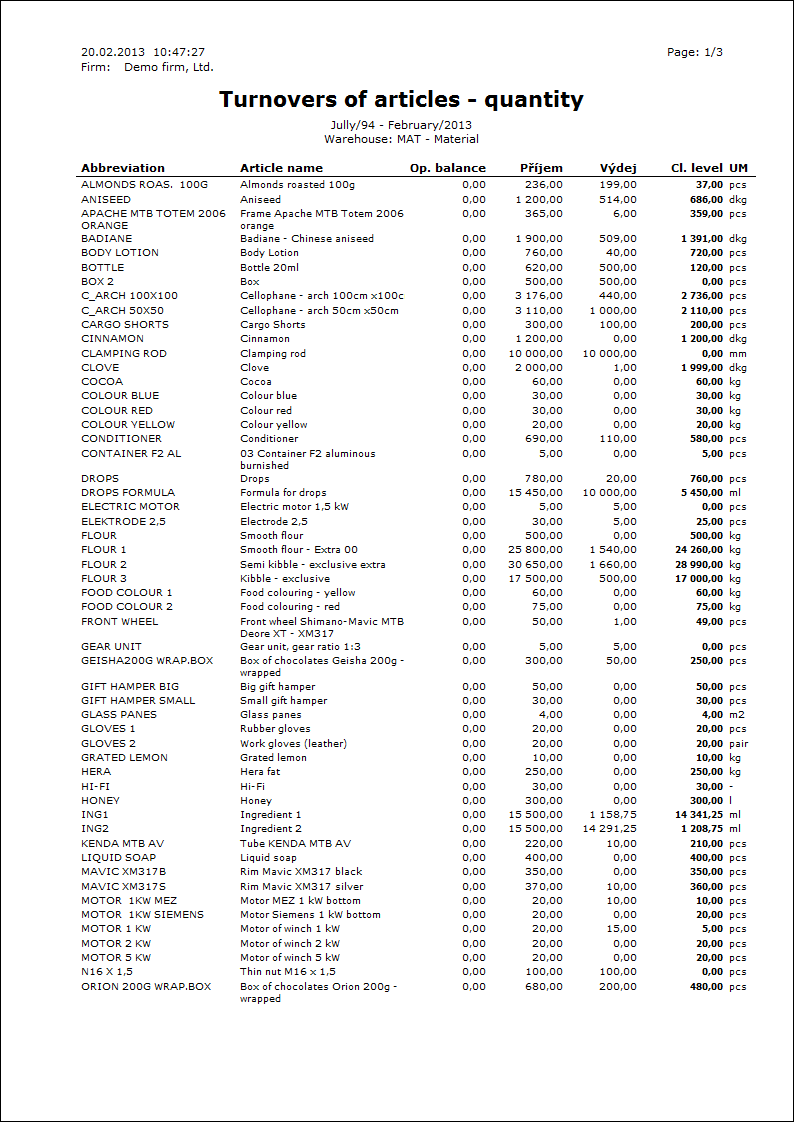Articles
The Articles database contains the list of all articles, materials, products, semi-finished products and other special types of items, which are entered into documents, that are used in the individual modules of the program K2. There are all information about an article on the Articles card: VAT rate, min. level in stocks, purchase and sales prices, turnovers and movements of articles etc.
Each article has its internal number that is automatically assigned by system (after saving by pressing F2 key) and that serves to a unique identification of articles in K2 IS.
It is not possible to cancel the created Articles card. You can only make them invalid by the F8 key. Invalid means that in the Book status the cards are not visible and you can not work with them. Invalid cards are accessible only in the Evaluation filter off status. Invalid cards have an icon of a red check mark displayed next to the Abbr 1 field on the 1st page of the card ![]() . If you press the F8 key again you make the record valid.
. If you press the F8 key again you make the record valid.
Articles book
In terms of monitoring the stock records, it is essential to set the required stock and current period. Then displaying of the stock information relates to these settings. These data are also important for a printing of stock reports. A set period and a warehouse are displayed in the upper blue bar of a screen. You can change a period or a warehouse by using Alt+F10 keys.
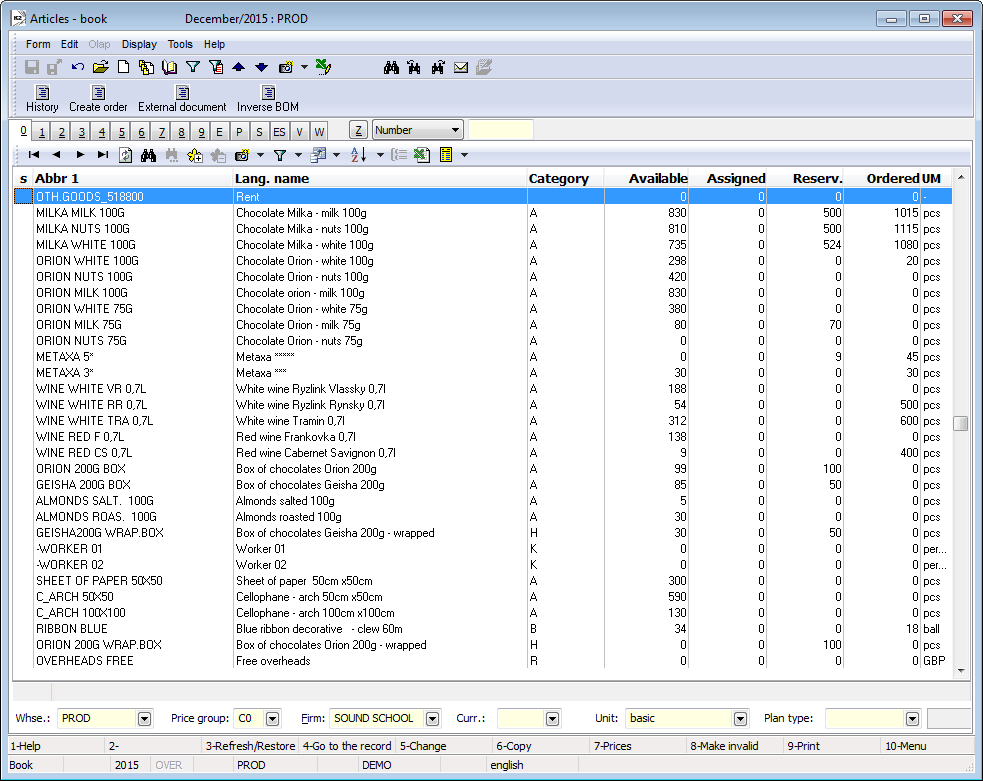
Picture: Articles book
Columns description:
Abbr 1 |
Abbreviation 1 from the 1st page of an Article card. |
Lang. name |
Name from the 1st page of an Article card. |
Category |
Category from the1st page of an Article card. |
Available |
The number of an article units that is available at a selected period and in a selected warehouse. If you confirm a Receipt Card, the quantity defined at a Receipt Card will be added to the quantity in the Available column. With a creating a Release Note or a Transfer Note the quantity defined at a Release Note or at a Transfer Note will be deducted from the Available quantity and will be added to the Assigned column. After you confirm a Release Note or a Transfer Note the quantity will be deducted from the Assigned quantity. Note: In the case of the double confirmation of documents the quantity defined at a Receipt Card will be added to the Received column (it is not a default column) during the first confirmation of a Receipt Card. During the second confirmation this quantity will be transferred to the Available column. By displaying the "BFIsAvailable" column, you can indicate the available in some warehouse of a firm to a user - in this case the icon |
Assigned |
The number of the Article units on which a Release Note or a Transfer Note has been already issued but an Article is still on the warehouse physically (a document is not confirm yet, an Article is assigned). With a confirmation of a Release Note or a Transfer Note the number of units will be automatically deducted from the Assigned (an Article is not physically on a Warehouse). The value is displayed only if the current period is set. |
Reserv. |
A number of the Article units which is necessary to ensure for a customer, a branch or for a production. According to the nature of the request the article can be reserved by using reserving cards, transfer notes and job cards. You can miss an article on a warehouse at the moment and it is important to order or to produce it. Otherwise an article is on a warehouse but a customer takes over it later. A release note will not be issued to the Article will not be blocked for any other sale. An article is only reserved. An information for who and for when the Article is reserved is stated in the Reserving Cards. Note: The quantity from the documents is loaded to the column. Their plan type is selected in the lower part of the screen in the Plan type field (the Plan Type is described in the Basic Code Lists and Supporting Modules K2 - Plan type chapter). The column does not load the free Reserving Cards. Displayed values are independent on a selected period. The quantity that is loaded on the basis of job card and reserving cards is also independent on a currently set warehouse. Only when loading quantity from transfer notes, the currently set warehouse is respected. |
Ordered |
That is the quantity of Articles units that is ordered by using purchase orders but it has not accepted into a Warehouse yet. The issue of a Receipt card and its confirmation deducts the quantity on a Receipt card from the Ordered quantity and adds it to the Available. An order confirmation without issue a Receipt card is understood as a solution of purchase and a data in this column is corrected. At Products and Semi-finished Products the quantity of Articles units which is in the headers of unconfirmed Job cards will be added to this column. The quantity in a Job Card header will be deducted from the Ordered column and it will be added to the Available column by a Job Card completion and its confirmation. You can order also by using transfer notes. Note: The quantity from the documents is loaded to the column. Their plan type is selected in the lower part of the screen in the Plan type field (the Plan Type is described in the Basic Code Lists and Supporting Modules K2 - Plan type chapter). In the case of the double confirmation of documents the quantity in the Ordered column will be deducted and it will be added to the Received column (it is not a default column) during the first confirmation of a Receipt Card. During the second confirmation this quantity will be transferred to the Available column. Displayed values are independent on a selected period. The quantity, that is loaded on the basis of purchase orders and job cards, is also independent on a currently set warehouse. Only when loading quantity from transfer notes, the currently set warehouse is respected. |
Note: It is possible to display the quantity not only in basic units, default units but also in an exactly specified unit (see bellow) in the individual columns.
Description of the fields in the lower part of the screen:
Warehouse |
A current warehouse from which all the information are taken. Data about states of the articles which you can see on the screen are data from a current warehouse. An abbreviation of a current warehouse is also displayed in the upper blue bar on the screen. You can change a warehouse directly in this field or by pressing Alt+F10 keys. The Set period and stock form is open. In this form you can set besides a period also a required warehouse in the Warehouse field. |
Price group |
It influences displaying of a Selling price in the Price group column ("CFDealC") - the column is not displayed by default. A Selling price that is valid for an appropriate price group will be displayed when you enter an appropriate price group. If the Selling price for this price group does not exist at an Article then a price according to the Unsorted price groups client parameter is displayed. |
Firm |
It influences displaying of a Selling price in the Price group column ("CFDealC") - the column is not displayed by default. A Selling price that is valid for an appropriate customer will be displayed when you enter a selected firm. A displaying of a customer price has a priority over a displaying of a price for a price group. If the customer price at an appropriate firm does not exist at an Article then the price of a selected price group is displayed. |
Currency |
It influences displaying of a Selling price in the Price group column ("CFDealC") - the column is not displayed by default. The Selling prices defined in a selected currency are searched during entering a currency (for an entered price group or a customer). If there is such a price then it is displayed. If a price in a currency does not exist a price according to the rules described at the Price Group and Firm fields is displayed and this price is recalculated pursuant to a rate into a selected currency. |
Unit |
An unit that is selected in this field will influence values in columns that display the quantity of Articles (e.g. Reserved, Ordered, ...). An unit, into which the article is calculated, is displayed in the UM column. In this field, there you can select a basic unit, default unit for Purchase/Sale, for production and transfer notes, and also a completely concrete unit of measure (the option "other" and unit selection from a displayed menu. If the required unit is not set on an Article card the basic unit will be displayed and on it recalculated values. |
Plan type |
Selection of a plan type from the Plan type code list. The quantity for Ordered and Reserved fields will be calculated according to the plan type. |
|
The button for a coverage settings. By a coverage settings you can influence loading of the records into the Coverage of demanded article function. This settings influences then the loading of the requirements and their coverage. |
Articles card
Articles card is divided into 9 numbered pages, pages relating to concrete modules follow. These pages are marked by the letters. If in a Browse mode in the Articles book you select by the light indicator a concrete Article card and press F4 or Enter key, you get on the previous opened page of a selected card in the Articles book. The same data you can see in a Change mode after pressing F5 key.
Basic data (1st page)
On the 1st page of an Article card the basic data a stated.
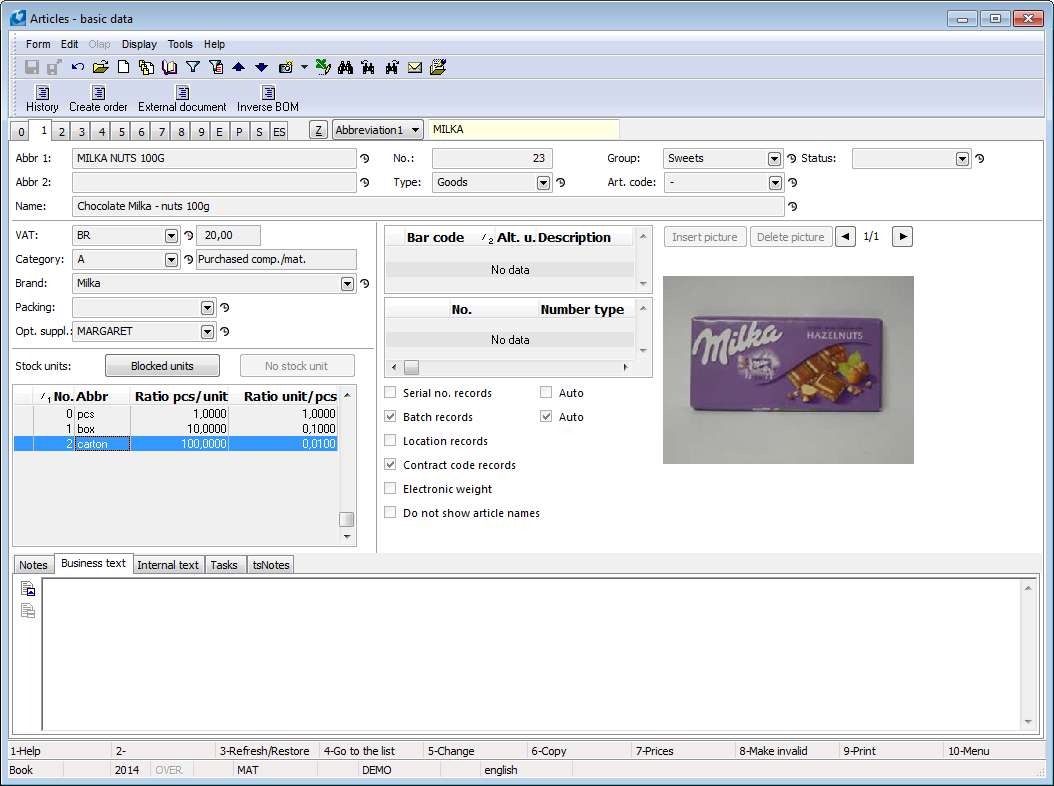
Picture: Articles - 1st page
Fields Description:
Abbr 1 |
Obligatory unique article identifier. By this abbreviation can be hidden either article name or its part of name or random code (e.g. numeric). According to the abbreviation 1 you can search an article from a book. Abbreviation is standard given in quantity 30 characters. Note: Notion abbreviation has got English meaning in the database Suppl./Cust. and in the database Article. |
|
Abbr 2 |
Filling of the field Abbr 2 isn't obligatory. It is possible to use it e.g. for PLU, etc. |
|
Name |
Field for entering the complete name of an article. |
|
No. |
It is a registration number of an article which is created automatically during the first saving of the Article card. Actually a registration number is an order number of an entered article. Note: In the Client parameters on the 2nd page it is possible to check the option Enter article No. which enables to manually enter an article number on a new card. |
|
Type |
Type of Article. Obligatory detail. |
|
|
Non-stock items |
A stock level is not counted for non-stock items. By a recalculation, it is possible to calculate only turnovers. |
|
Packing |
It behaves like stock item, but it is always appreciated by fix prices (it means accounting part of the Stock recalculation function does not process these cards, physical part of recalculation does). Turnover record is counted for packing regardless of Customer / Articles record option in Clients parameters. |
|
Breakdown |
You set up e. g. Computer card and on the 3rd page you define a list of article which you sell with name Computer (e.g. monitor, keyboard, mouse). During the inserting this card on a sales order, a list of an article is displayed. Card with a name Computer will not be displayed. |
|
Article brdown |
You set up e. g. Computer card and on the 3rd page you define breakdown of article which you sell with name Computer (e.g. monitor, keyboard, mouse). During the inserting this card on a sales order, a breakdown of an article is displayed with Breakdown type, that means including the Computer item. |
|
Discount |
Value had got meaning in the lower versions of IS K2. |
|
Stock item |
Stock items have got influence on a stock records. |
Group |
Group is a random number or text, which every article has to have assigned. Instead of text in this field can be entered dash too, that means it won't have got assigned a concrete group. By this division the database Article breaks up to the smaller and clearer groups with the collective properties (e. g. groups Grocery, Tools, Spare parts ...). Note: Record from the Group code list can not be deleted in the case, when the given group is used on some Articles card. |
|
Article code |
Article code is a random number or text which every article has to have assigned. In this case a dash can be entered in this field. According to the article code it is possible to divide goods for example to inland software or foreign software, alcohol to beer, wine, spirits, etc. Article code can enter to accounting as a complementary (helping) analytics of appropriate accounts. |
|
VAT documents |
VAT rate code list. |
|
Category |
Article category is the key code list for a production. It serves to distinguish articles on materials, outputs, semi-finished products, products etc. Each article category has different properties, which determine its behaviour in production. The category properties are set on the 1st page of the Category card. Costing models for calculation of products and semi-finished products prices are also defined in categories. Article category influence option of sorting of the Article card to the individual documents and option of separated print in the documents too. Detail description is described in the Master Data of Production module - Article - Article category chapter. |
|
Brand |
Brand or producer of article. It is possible to choose some record from code list or enter random name. |
|
Packing |
Information of this item are deducted from the Article card. It is package of the produced product, for which a new separate Article card has to be created. If you insert the Article card with a defined packing field, then the packing is automatically added in a document. |
|
Opt. suppl. |
Here you can set an optimal supplier that means supplier who satisfies your requirements best. The selection is executed from the Suppl./Cust. card. The field is important when recalculating of stock prices according to the optimal supplier price in the case that the price is defined on the 5th page of this supplier and when ordering by Create POs for requested goods function. |
|
Stock units |
The stock records, the economic records (at energy deliveries, at transport) is kept in this stock unit e. g. pcs, m, kg/pcs, GBP/km (of transport), GBP/hour (of training) MWh, etc. Apart from basic stock unit, on each Article card the next stock units that have a certain proportion to the basic stock unit can be defined. E. g. The basic stock unit can be pcs and the others stock units can be package and kg. By pressing Ins key in the table of stock units you can insert a new stock unit. The usage of stock units is applicable so that a quantity of high numbers did not have to be placed in the documents. If you use the possibilities of next stock units, it is methodologically recommended to select the smallest unit as a basic (first entered) unit. |
|
Blocked units |
By this button you display the stock units that had been blocked and they are not used at the moment. |
|
No stock unit |
The button simplifies the setting of unit in the Article cards where the unit is not important (especially a card other than articles). By using of this function you save manual filling of data - record of basic unit with unit of measure "-" will be automatically created. |
|
|
No. |
Unique number of stock unit. User doesn't influence this number. Unit with number 0 = is basic stock unit. This fact is described at this unit too. In a column of the flags at the units on the 1st page of Article card the symbol "•" informs about basic unit. |
|
Unit of measurement |
Abbreviation selected from a code list of units of measure. |
|
Proportion basic / current unit |
Ratio determined quantity of basic units to one currently entered unit. It is in inverted value at the field Cur./basic unit ratio and after change of one of these fields the second value will automatically count. |
|
Cur./basic unit ratio |
Ration determined quantity current entering units in one basic. Towards the field Basic ratio / cur.unit is in inverted value and after change of one of these fields the second value will automatically count. |
|
Width, Height, Depth |
Field for entering the unit dimensions. Field serves only for records, it is not used by standard. |
|
Measure unit |
Abbreviation of selected stock unit. |
|
Net weight (kg) |
Weight of article without package. This weight is used the function Calculate product weight. It enters only on basic unit. |
|
Gross weight (kg) |
Weight of appropriate stock unit of article with package. This weight is used during the calculation of item's weight and than document. |
|
Capacity |
Space for entering of a capacity of stock unit. Field uses only to records, it isn't used by standard. |
|
Capacity unit |
Specification of the field Capacity. |
|
Integer unit |
During the using of this field and unit in sale item / purchase item will be control if entered value is integral. If it isn't, than an option for rounding up or down to the nearest integral value will offer to user. Integers is controlled in production too. |
|
Default for purchase |
By checking this field the stock unit is automatically set after articles selecting in the Purchase item. The field can be checked only in one item. If the flag is cancelled in any item, it will be automatically set in a basic unit. |
|
Default for sale |
By checking this field the stock unit is automatically set after articles selecting in the Sale item. The field can be checked only in one item. If the flag is cancelled in any item, it will be automatically set in a basic unit. |
|
Default for production |
By checking this field the stock unit is automatically set after articles selecting in the Job card item. The field can be checked only in one item. If the flag is cancelled in any item, it will be automatically set in a basic unit. |
|
Default for transfer notes |
By checking this field the stock unit is automatically set after articles selecting in the Transfer notes item. The field can be checked only in one item. If the flag is cancelled in any item, it will be automatically set in a basic unit. |
|
Default for internet shop |
By checking this field the stock unit is automatically set after articles selecting in the Internet shop item. The field can be checked only in one item. If the flag is cancelled in any item, it will be automatically set in a basic unit. |
|
Block the unit / Unblock the unit |
If you do not want to use any stock item for this article card, you can block it. The unit will be neither offered nor displayed, if the button Blocked units is not on. Blocking will automatically cancel possible checking of Default units fields at the same time and will display the flag On a blocked unit the button will be changed to the Unblock the unit button. This operation can be executed only on the last entered unit with an appropriate unit of measure. |
|
Save as New One |
This button enables to save actually edited unit as a copy and it blocks the original unit at the same time. It is very suited to use this function especially if the ratio of a unit changes to a basic unit, because the correction of a previous unit would cause very important change of existing documents. |
Bar code |
The table of bar codes enables to register the various bar codes to various units of an one Article card. A new code is inserted by pressing Ins key in the table. For the code, we also register, whether it is used for EDI or whether it is a default bar code. This information is used in the web shop when exporting the articles for price comparators. |
|
Supplementary article numbers |
It serves to define other identification data for the given article card. It can be "Product Number" (P/N), that is also often displayed in i-shops and it serves to search for e.g. an appropriate spare or alternative part. |
|
Serial no. records |
If this field is activated, then the items with this article in the stock documents and job cards have to contain serial numbers, otherwise the program will not allow to confirm a document. Detailed description of the serial numbers is stated in the Purchase and Sale Shared Elements - Serial numbers chapter. |
|
|
Auto |
This value enables to create automatically the serial numbers when confirmation of a receipt card. Detailed meaning is stated in the Purchase and Sale Shared Elements - Serial numbers chapter. |
Batch records |
By checking this field, the batch will be required in all stock documents items. |
|
|
Auto |
If this option is activated, batch for receipt items: positive item of receipt card, negative item of job card, header of job card, is automatically created when confirmation the stock document. |
Location records |
A location serves to a detailed stock structure. If in an Article card the Location records field is activated and on the 1st page of an appropriate stock the Location records field is activated at the same time, then the location is required on all stock documents. |
|
|
Auto |
If the option is activated, then there is a proposal of location for the receipt of article to the warehouse. Location for the item is proposed at the time of inserting the article card into the receipt item. Release notes: location is proposed according to the optimal location defined for warehouse / zone / Business year (the 4th page of the article, Article/warehouse data table). Receipt cards, transfer notes: location is searched according to the existing inventory of the specified article card at first, if an article is not found at any location, then according to an optimal location, which is defined for warehouse / zone / period. A rule, that a proposal for a location takes a current location load into account, it means that it is compared, whether a location capacity will not be exceeded by the receipt of a current item, always holds. |
Contract code records |
If in an Article card the Contract code records field is activated, then the stock record will be calculated for the contract codes. At the same time, it is necessary to activate the Contract code records option on the 1st page of the appropriate stock. |
|
Electronic weight |
Electronic weight is used in the bar codes where the weight is coded. |
|
Do not show article names |
By checking the Do not show article names field, you define that in the documents, where the article is, only the text, that is entered in the Description field (on an item of purchase or sale) or in the Name field (on an item of a transfer note or on a job card) is displayed. Otherwise the text will be understood as a supplement of an article name. |
|
Activation / deactivation of the option of an auxiliary stock records
If the Do not check the setting of stock record in Articles client parameter is not activated, then the Serial numbers records, Location records, Batch records, and Contract code records options can not be activated / deactivated in the case, that non-zero stock level exists for the article (non-zero Received or Available or Assigned or Dispatch).
If you have the article image, you can add it by pressing the Insert picture button. The picture appears to the right of the bar code. These pictures serve to creating of offers in the Marketing module. A picture you delete by pressing of the Delete picture button. Associated pictures will add automatically on the 9th page into the Attached documents part. By double click on this picture, you can open it separately in a browser.
On the 1st page of Article card, it is possible to work with the notes in a Browse mode by Notes, Business text and Internal text tabs. As Business text, the note (supplement) of DH type, that is automatically printed in the Offer and Offer with pictures reports, will be inserted. It is possible to display it by parameter on the others purchase and sale documents. As an Internal text the DF note (supplement), that is determined for an internal information and is not set to a print anywhere, is inserted. The detailed description is in the Basic Code Lists and Supporting Modules K2 – Notes chapter.
Prices and others data (2nd page)
On the 2nd page of an Article card the informations about purchase prices are contained.
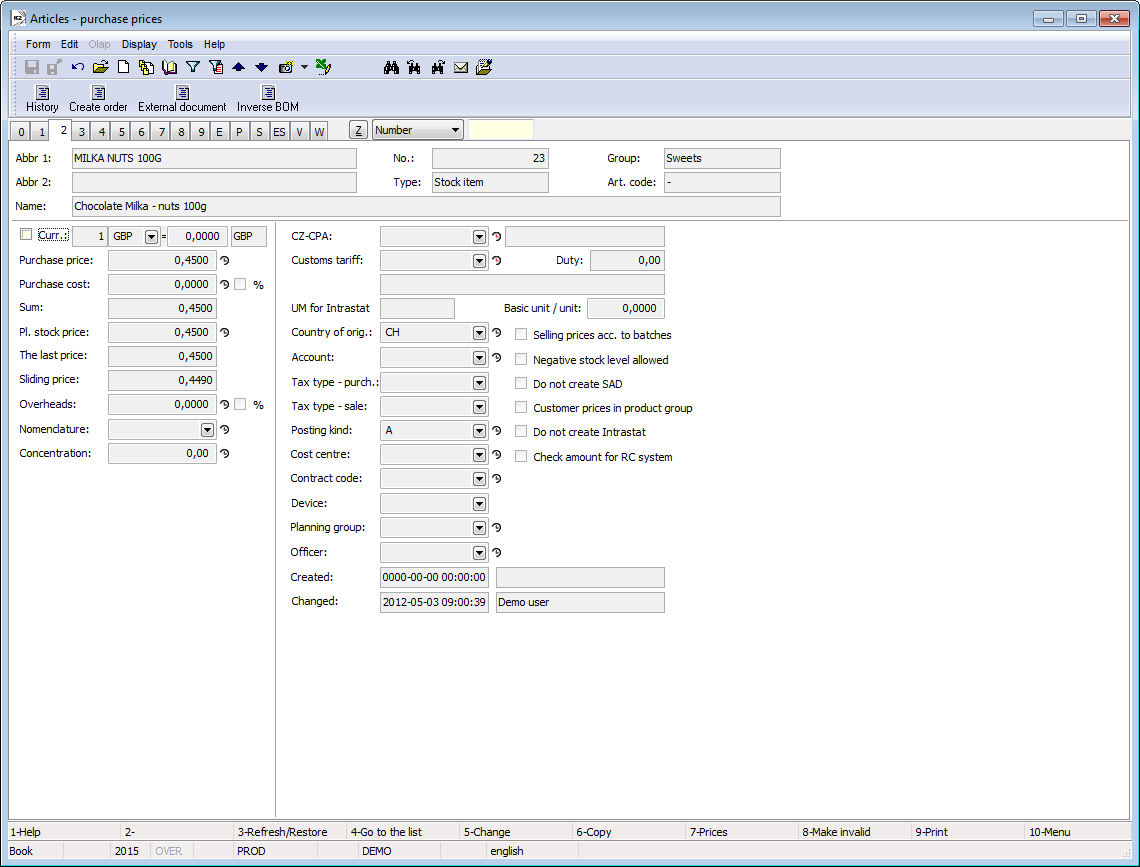
Picture: Articles - 2nd page
Fields Description:
Currency |
If the field is not checked, you insert the prices in a basic currency. If this field is checked, you insert the prices in a selected foreign currency. After checking/deselecting the recalculation will be automatically executed between the basic currency and a selected currency according to a entered rate. The currency is considerate when selecting of a suited supplier price when calculation of a Purchase price by the Recalculate article price. |
Purchase price |
Estimated purchase price excluding VAT. |
Purchase cost |
Cost associated with the acquisition of articles (e. g. transport, premium, commissions etc.). They are given either as a percentage of the purchase price (the absolute value of the purchase cost will be automatically derived from the purchase price and from defined percent) or in absolute value. This field is used to compute the costs associated with the acquisition of articles. Field value will be entered into the PC field (planned incidental costs) when inserting article into the purchase item. |
Sum |
The sum of Purchase costs and Purchase price appears automatically. In the Article card is only displayed. |
Pl. stock price |
This field does not calculate K2 IS, but a user can enter it. If the invoice price (price of invoice in) is unknown when incoming of article, then the value of this field is entered into the receipt card as a receipt price. A price from this field serves for product praising too, if you price the products by a fixed stock price. The field is updated by Recalculating of stock prices (it is possible to enter it by a sliding price, last price, etc.), at products and semi-finished products by Recalculate products (it calculates the price on the basis of the routing variant). |
The last price |
The price of the last confirmed invoice in that has confirmed a receipt card for this article too (at least 1. confirmation). |
Sliding price |
Article sliding price for an accounting warehouse. It is calculated as the current quotient of the value of article on the stock in the client currency and the quantity on the stock. It displays the value from an accounting stock which includes a basic (physical) stock, that is currently defined in the Articles book by the user, or the value from the warehouse, that has the activated Default accounting option. It is also updated by the Stock recalculation function. Note: When the available quantity in the stock is zero, the value of a sliding price equates to a price of the last moving (because of a correct price making). |
Overheads |
In this field you can enter a surcharge (a production overheads) that serves for production evaluating absolutely or in percent. This also enters into the calculation of the stock price of the product according to the specified costing model (see the Master data of production module - Article - Article category chapter). |
Nomenclature |
The field you fill only in the article cards that subjects to an excise. In the field you select a six-digit code under that it will be stated in an excise return. This code has attached the excise rate. The excise rate is stated in relate to an unit of measure that is specified in law on excise and this unit has to be stated as the one of the alternative stock units in the Article card, otherwise K2 IS declares an Error. The defined value and associated excise rate are automatically copied into the purchase and sale item. |
Concentration |
This field is filled only in Article cards, that subjects to excise tax on alcohol (you enter the percentage content of alcohol in the product in decimal number form, i. e. 40 % enter as 0.40) or excise tax on beer (enter the number of whole degrees Plato). |
SCP |
Classification issued by the Czech Statistical Office. It serves to ensure international comparability of statistical indicators. |
Customs Tariff |
The Customs tariff code list is described in detail in the Basic code lists and supporting modules K2 - VAT rate / Customs tariff chapter. |
Duty |
This field serves only for displaying of the percentage amount of duty. |
UM for Intrastat |
It displays the unit of measure for Intrastat. The value is filled in the Customs tariff code list. This field can not be edited, it is possible only in the Customs tariff code list. |
Basic unit /unit |
The ratio of unit of measure of Instrastat to the basic unit is assigned. Note: If the value remains zero, then it will warn on this fact during the Intrastat calculation and the appropriate article will not be loaded into the Intrastat. If the given card does not enter into Intrastat, then the value can remain zero. |
Country of orig. |
To the Article card you can assign country of origin that can have continuity in the Purchase and Customs module. |
Account |
Account from the accounting classifications. It is filled in the cards of Other than goods type. |
Tax type - purch. |
Tax type that will be filled into the purchase item. |
Tax type - sale |
Tax type that will be filled into the sale item. |
Posting Kind |
Kind according to that the articles will be posted on the stocks. You can edit this field if there is no stock movement on the Article's card in the business year, that is blocked for changes in accounting. Note: This field was created from the field Category on the 1st page of the Article card. For the needs of production, it is necessary to distinguish more Article categories, while for the needs of accounting, just fewer categories is enough. |
Cost Centre |
The cost centre that will be filled into the purchase or sale item. |
Contract Code |
The contract code that will be filled into the purchase or sale item. |
Device |
The device that will be filled into the purchase or sale item. |
Planning group |
The selection from a code list that you can define. This field is used for products and semi-finished products separation to various groups for planning. This separation is possible to use in the Capacity plan script (plan_capaplan.pas) where by GroupByPlanGroup parameter you can display requirements for source separated according to the planning groups. Example: The product A is produced in the source Line 1 and has defined the planning group A. The product B is produced in the source Line 1 too and has defined the planning group B. The requirements for this source that result from the cards booking to the product A and B are then divided in the capacity plan according to these two planning groups. |
Officer |
It enables to assign e.g. a responsible person to the article, it is a link to the Officers book. After selecting of this articles into the document the data will be copied to the item. |
Zero price |
The zero price is used for "simulated" cards e. g. for Other than goods items. After checking of this field zero will be entered in the stock and selling price of created documents. |
Selling price acc. to |
If on the 1st page of the Article card the Batch record field and Selling price acc. to batch are checked simultaneously, it is ensured that the final selling (invoice) price is the price according to the batch edited according to the defined price and product groups. In their definition the value Relative has to be checked. The condition is to have checked this field by an appropriate batch too (1st page of the Batches book), what occurs automatically according to the setting of this field. |
Negative stock level allowed |
By checking of this flag the negative states are allowed in stock records. Note: It is not recommended to allow it for the goods that is normally purchased and sold. It is used e. g. at any Article cards used in production. |
Do not create SAD |
By checking of this flag it is impossible to create SAD. That means if you create e. g. SAD from invoices in, then the SAD will not been created for these invoice items that has this flag on. |
Customer price in product group |
You check this field if you define customer price in a product group in a customer card and you do not do the recalculations of the Price groups and Customer prices. In this case the customer price will be found directly in the definition of a product group regardless if down on the 5th page of an Article is this price calculated. |
Do not create Intrastat |
Checking this checkbox forbids to create Intrastat for the specified article. If an article is in an invoice, which comes into Intrastat, then an article, in which this field is checked, does not come into Intrastat. |
Check amount for RC system |
It is checked in Articles cards, which subject to reverse charge system in the case, that the tax base amount exceeds 100.000 CZK. |
Created by |
Date and time of creation of the Article card and an user who createdthe record. |
Changed |
The date and name of the user who made the last change. |
Routing (3rd page)
Third page of the Article card is divided into three parts.
Routings
The first table serves for displaying of individual variants of a routing. The setting of the routing is executed in the Alternate routings book. Two fields in the header of this page are linked to the routings:
Fields Description:
Variant |
A default (basic) routing alternative of a product. Alternative will be entered according to the setting of Default value in alternate routing. Or vice-versa, by setting of an alternative to this field the activation of a value Default in the routings will be adjusted. By invalid of a default alternative in the Alternate routings book the value in this field will be deleted. |
Copy |
Setting, which routing variants will be copied when copying the article cards by F6 key.
|
Show blocked routings |
Invalid Alternate routings are not default displayed. Activation of this value you can display them. |
The detailed description of this problem is stated in the Master data of production module - Routings chapter.
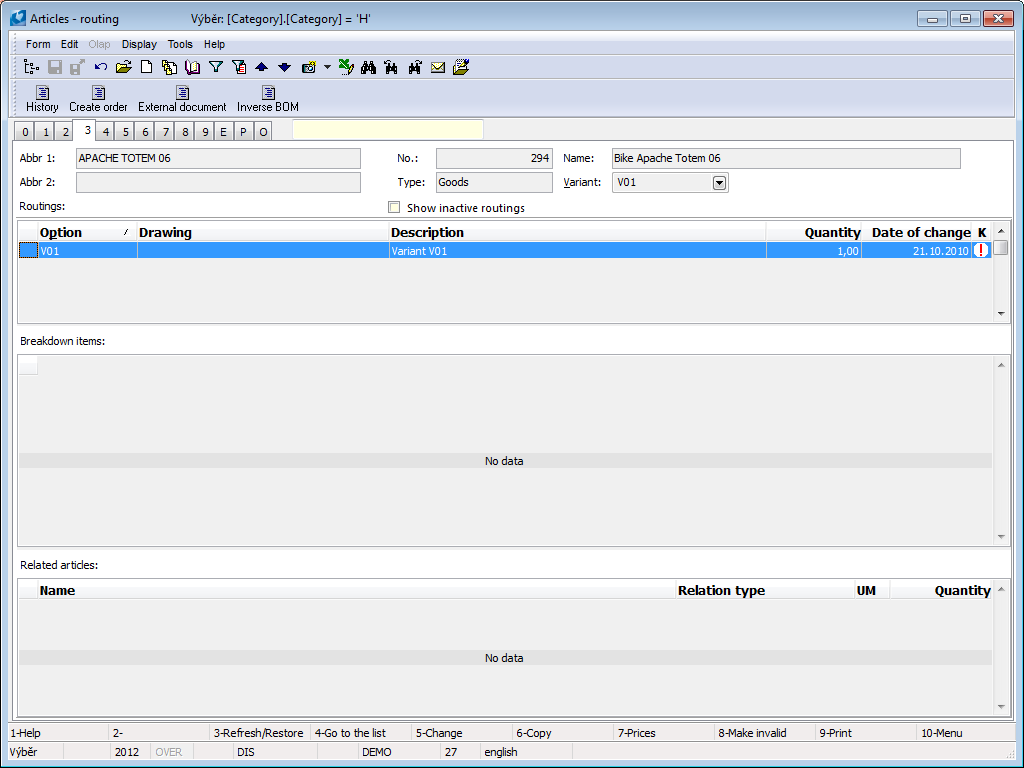
Picture: Articles - 3rd page
Breakdown items
The next table serves for definition of the breakdown items. The breakdown items you define to the article cards with the type Breakdown and Goods breakdown. The definition of Breakdowns on the 3rd page of an Article card serves only for Purchase, Sale and Warehouse modules. The breakdowns for production you define in the Alternative routing book. The article card with a Breakdown or Goods breakdown type has to have its own alternative in a Alternative routing book and items of breakdown entered as routing items for usage in the production. The detailed description in the Basic code lists and supporting modules K2 - Articles - Article card - Basic data (1st page) chapter.
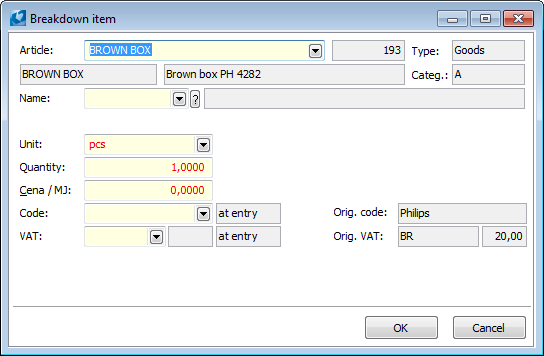
Picture: Articles - 3rd page - Breakdown item
Selected fields description:
Price/UM |
Price of breakdown item. This field is not used in standard, it servers for special edits of program. |
Related articles
The third part of this form serves for expression of a relationship of various article cards. The type of relation you define in the Relation field. Standardly, this is the "related, alternative" and "variant" article type, e.g. for needs of i-shop. You can add next relation types according to your needs.
Article variants
The forth part of the form is related to K2 web shop and serves for grouping article groups under one product, which will represent its variants.
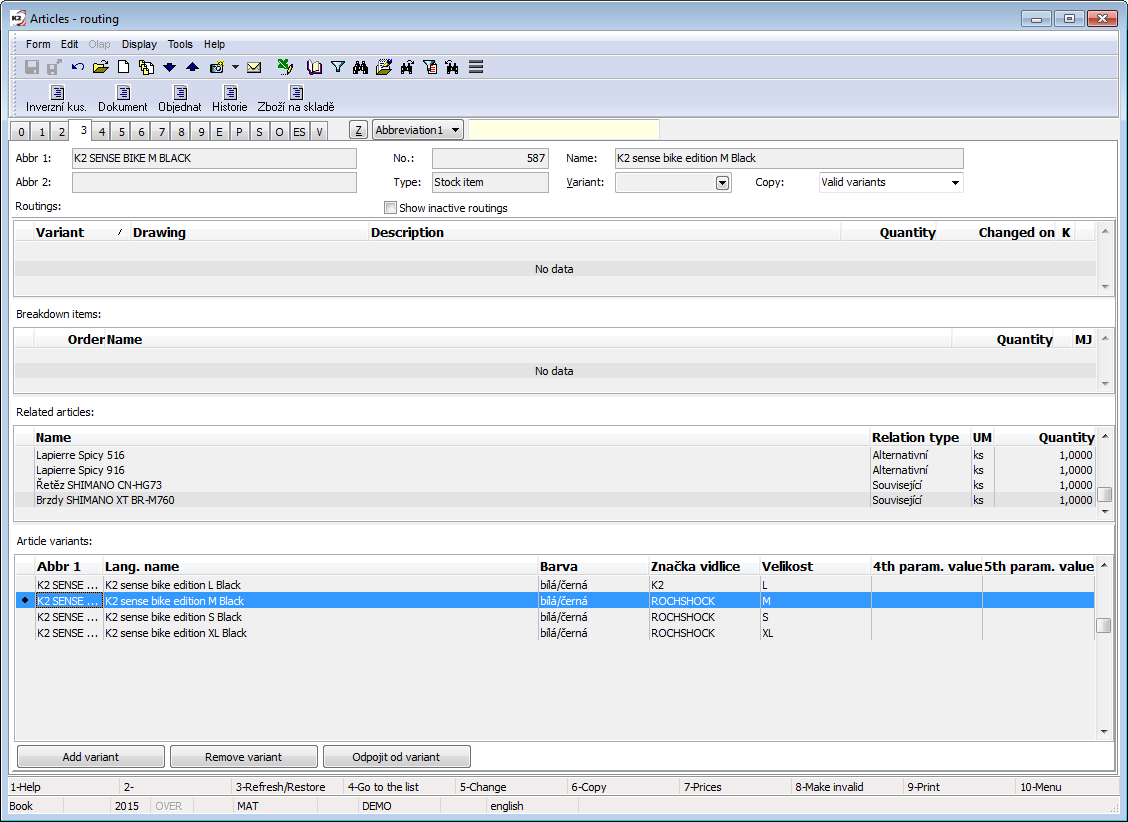
Picture: Articles - 3rd page - Article variants of K2 web shop
If you want to see some parameters (i.e. distinguishing) for Articles cards, it is necessary to set the Parameter for distinguish article variants characteristic in the Class for these parameters. The first 5 parameters with this flag will be displayed in the table.
If you want to edit the order of displayed cards, it is necessary to:
- Cover up a parameter, according to which you want to sort, into Class, where it is necessary to set the Parameter for distinguish article variants characteristic (by what the parameter will be also displayed in a column in this table) and Sort by comparing value characteristic.
- Fill in the parameter value for comparison (Comp. value field) on the Article card: For filling the value it is necessary to call change form by Shift+Enter key combination. Enter the number value - e.g. in sooner used unit, order of sizes XS = 1, S = 2, M = 3 etc.
Supplier prices (4th page)
The 4th page of the Article card is used for case when a business partner delivers goods by system of fixed prices and its adjustments according to the product groups, multipliers and the codes of article. Added supplier price displays on the 5th page of the Suppl./Cust. card.
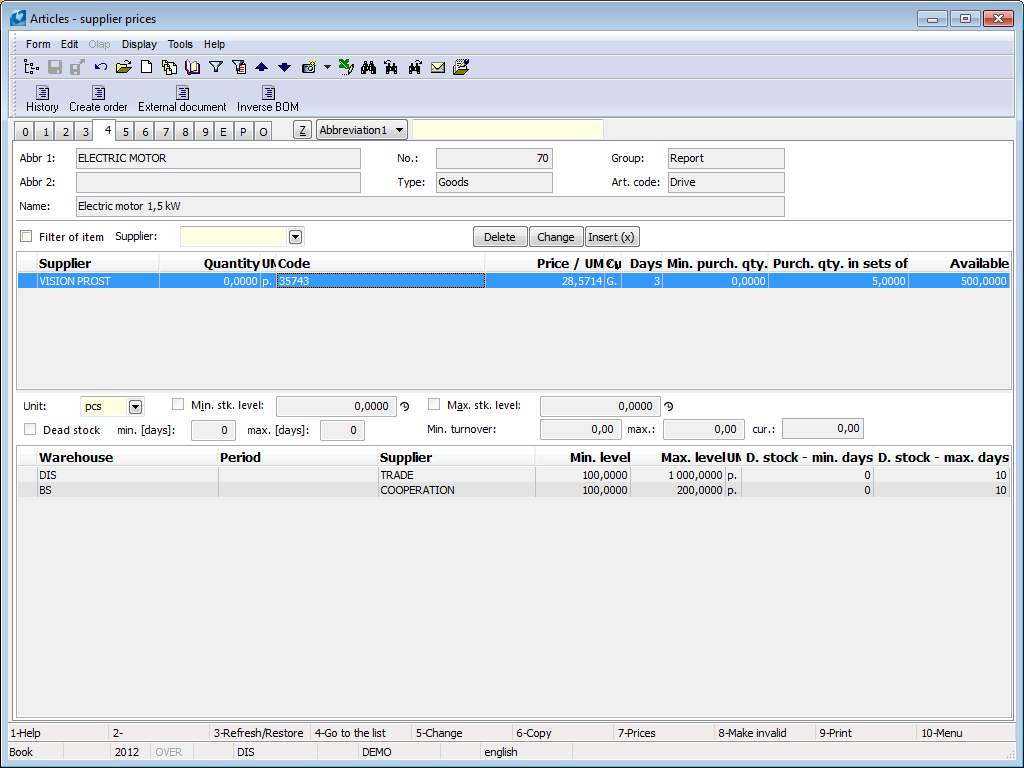
Picture: Articles - 4th page
Upper part of the card can be controlled in the Browse mode by the buttons over the table, in the Change mode extra by the standard keys. In the called Supplier prices form you insert the new supplier prices by Ins key or by the button Insert (x). You open the same form for performance changes in existing records by the button Change or by Enter key. The button Delete or by pressing Delete key you use for deleting selected Supplier price.
If the light indicator is positioned on submitted supplier, you can open the Suppl./Cust. book by pressing Ctrl+Enter key in a Browse mode and you can see the card of a selected business partner.
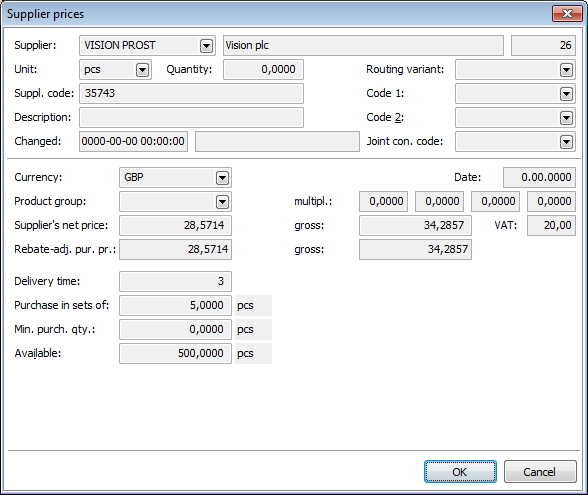
Picture: Supplier prices form
Fields Description:
Supplier |
Supplier. |
Unit |
The field for a stock unit setting to which the price applies. |
Quantity |
Quantity of articles from which above (including) the supplier price is valid. Default quantity should be equal to zero. |
Suppl. code |
It is marking an article used by supplier. |
Description |
In a Description field you can set the next comment to this article. |
Changed |
The date and a user name who made the last change of the record. |
Routing variant |
Some articles delivered can have more routing variants. It can serve for user identification. |
Code 1 |
Possibility of setting any code. Serves for user identification. |
Code 2 |
Possibility of setting any code. It serves for user identification. |
Joint Contract Code |
It indicates contract which the supplier price related to. |
Currency |
The currency in which the price is specified. If the field is not set, the price is in a basic currency. |
Date |
This field is useless in the IS K2. |
Product group |
Product group is relevant only if you edit the multipliers of a price or if you want to set supplier price rounding. Product group is assigned to a specific supplier. You select the product group from the book Supplier product groups. Here you can define a new product group by pressing F6 key (or Ins) or change (including multiplier values) whichever product group by F5 key. After selecting a product group the multiplier values will be automatically entered into the appropriate fields. Set rounding applies on calculation of the field Rebate-adjusted purchase. |
Multipliers |
Multiplier means a figure that provides the possibility to take into consideration various variances of supplier prices (discounts,... - multiplier <1; transport, surcharges >1 etc.). For each product group, you can specify four such factors that are further reflected in the net purchase price of articles. Multiplier values are set in book on the 1st page of Supplier product groups card. |
Supplier's net, gross price |
By entering data to this filed you state which initial price is valid for appropriate product group per one stock unit. This is a price that the supplier has in his price list. Net price will be automatically recalculated to Supplier's gross price according to VAT rate defined in the Article card. The same calculation is valid vice versa too - after setting Supplier's gross price the Supplier's net price will be calculated. Note: It the supplier is stated as an optimal on the Article card (Opt. suppl. on the 1st page of the Article card), supplier's net price will take to an appropriate Article card as Purchase price (the 2nd page of Article card) after conversion (function over the filter of goods Article prices recalculation - Purchase price). |
Rebate-adjusted purchase price |
Rebate-adjusted purchase price is calculated from the Supplier's net price multiplied by all four multipliers. Correspondingly Gross purchase price is calculated from Supplier's gross price. A Rebate-adjusted purchase price is automatically entered into an order. Purchase prices only display in a form. |
Delivery time |
According to the provided data from supplier you fill the delivery time. |
Purchase in sets of |
Value indicates after which sets the goods can be taken from a supplier. You fill a field according the supplier data. For example script Create POs for requested goods works with field standard. |
Min. purch. qty. |
Value states minimum quantity which is possible to take from a supplier. You fill a field according the supplier data. For example script Create POs for requested goods works with field standard. |
Available |
Here you can fill the quantity of articles that is in the supplier warehouse. You proceed from supplier's provided data. Note: If you change unit of measure in the field Stock units, than the data in this field will display according to new selected unit of measure. |
After checking the field Filter of item the entered supplier prices are possible to filter according to selected supplier by selection of supplier in the field Supplier.
You can get to the supplier prices also from the Purchase item form by the button Supplier prices. Items of supplier's pricelist are default filter on supplier of the document. If you cancel checking the field Filter of item, you can turn off this filter and then you will see all items of supplier's priceslist of all suppliers.
By Enter key or by double clicks by the mouse the price from supplier's price list, where the light indicator is, inserts to the form Purchase item.
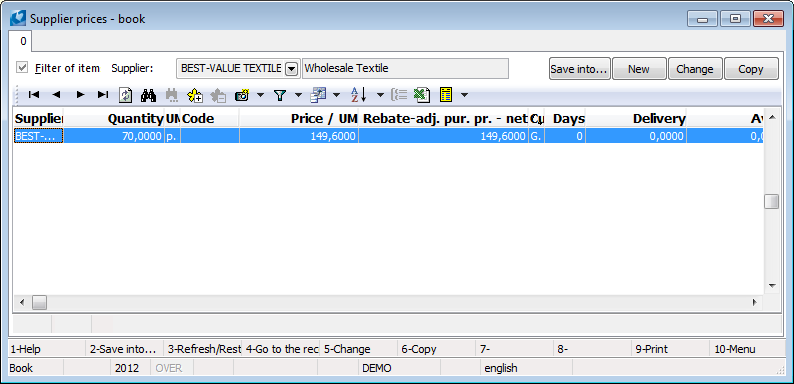
Picture: Supplier prices form activated from purchase item
By the button Save into... it is possible to save data from a purchase item (quantity and price of order) to the item of supplier's pricelist where the light indicator is. Before saving the change the Supplier prices form will open where you can edit particular data yet. It can be executed by F2 key too.
By the button New you can save data from purchase (quantity and price of order) item as a new item of supplier's pricelist. Before saving change the Supplier prices form will open where you can edit particular data yet. It can be executed by Ins key too.
By the button Change you get to the change mode of supplier's pricelist item where the light indicator is. It can be executed by F5 key too.
By the button Copy you get to the copy mode of supplier's pricelist item where the light indicator is. It can be executed by F6 key too.
In the middle part of the 4th page of Article card, you can preset following data:
Unit |
Selection of unit of measure for entering/displaying the quantity in fields for min. and max. quantity. |
Min. quantity |
Minimum quantity which has to be on stock. Field activation and entering the quantities is of great importance for Coverage (see the Coverage of article demanded subchapter), and for some functions and output reports (for example Creating orders for demanded articles). |
Max. quantity |
Maximum quantity which can be on stock. Field activation and entering the quantities is of great importance for Coverage (see the Coverage of article demanded subchapter), and for some functions and output reports (for example Creating orders for demanded articles, Stocktaking / stock articles). |
Dead stock (days) |
Checking of the field Dead stock (days) activates pursuance of the dead stocks for appropriate article card. Given number of the days influences some output reports (for example Dead stock stocktaking). |
Validity to |
After the entered date, all data, which are necessary for logistical evaluation (Daily stocks, Turnover, ABC analyses) are transferred to calculations for a successor card. It means, that daily levels in stocks and daily levels of sale after this date are included into a calculation of turnover and into ABC analyses of a successor card. |
Successor |
It serves for entering the successor card. Data of the predecessor card after validity of predecessor card are counted into the evaluation of this card (Daily stock, Turnover, ABC analyses). |
In the lower part of the 4th page of an Article card, you can set the data for the article / stock / zone / period combination.
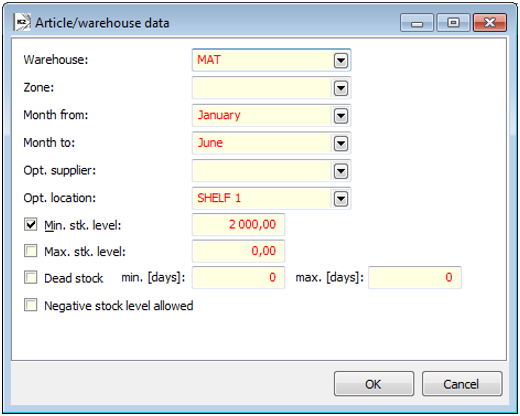
Picture: Article / Stock form
Fields Description:
Whse. |
Warehouse, which the set data relate to. |
Zone |
Warehouse zone, which the set data relate to. |
Month from, Month to |
Period (range of months), for which the set data are valid. |
Optimal supplier |
Optimal supplier for the entered combination. |
Optimal location |
Optimal location of the article for the entered warehouse / zone / period combination. Description of the rule for adding the location into a receipt is stated in the Basic data of article chapter, Location - Auto field. |
Minimum stk. level, Maximum stk. level |
Minimum and maximum allowable quantity for the entered combination warehouse and period. |
Dead stock, Minimum, Maximum |
The meaning of these fields is identical with the settings, which is valid for the Article card in the middle part of a form. |
Negative stock level allowed |
By activation this option, negative stock level is allowed for the entered data combination. |
Selling prices (5th page)
Selling prices are defined on the 5th page of Article card.
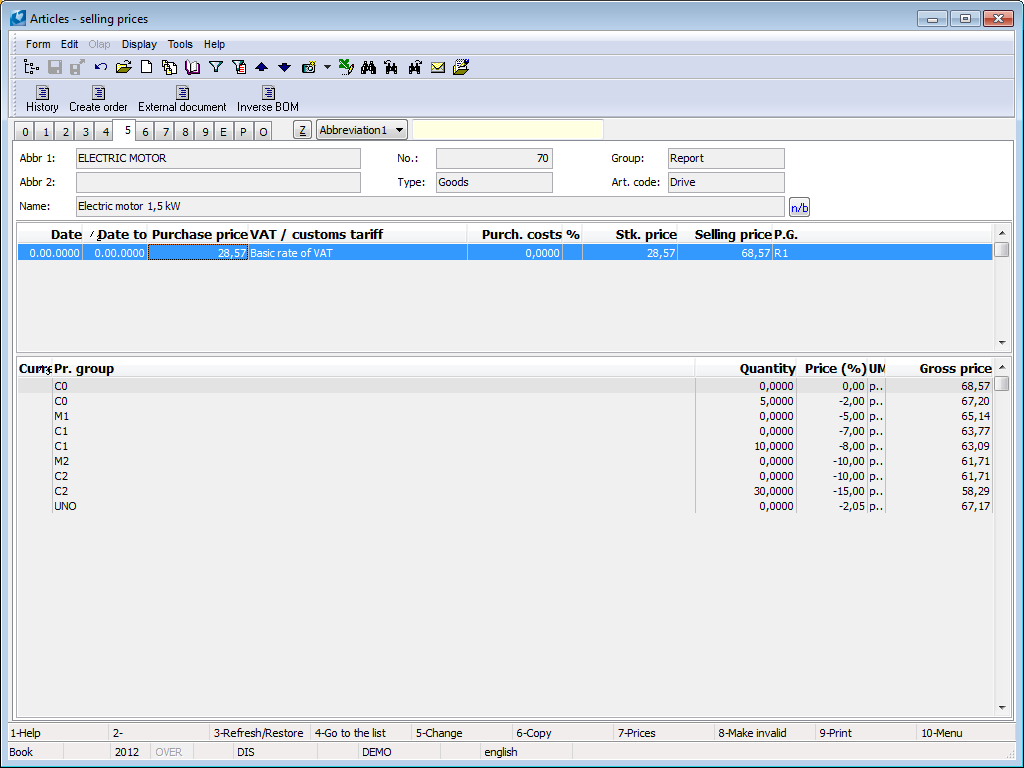
Picture: Articles - 5th page
The button 'n/b' is located in a header of 5th page of Article card. By this button you can switch display of net and gross price in Change mode and in Browse mode too. For change of these prices you can use Ctrl+Alt+B key as well.
In the upper part of the page in the 1st line, the basic selling price (current price) is automatically created, in other lines, you can define date prices (see the Date prices subchapter) by pressing Ins key in Change mode and subsequently by filling the Price list preparation form. The same form can be called by pressing the Enter key in Browse mode.
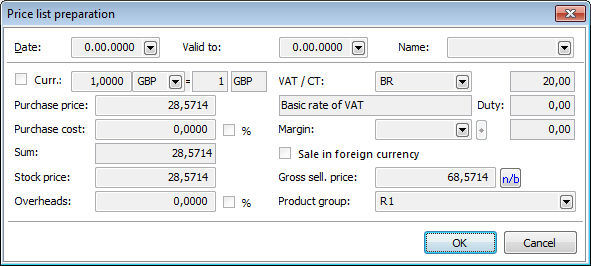
Picture: Price list preparation form
Fields Description:
Date |
Initial date of the price list validity. The field serves to define a date price validity. |
Valid to |
The last possible date of the price list validity. The field serves to define a date price validity. |
Name |
Name of an appropriate price list. |
Currency, |
In the case of current price, these fields are prefilled from corresponding fields on the 2nd page of the Article card. You can edit the values, the appropriate fields on the 2nd page of an Articles card will be simultaneously updated. In the case of a date price, this update will not be performed. |
Margin |
In this field you select an appropriate margin or you can define a new one (see Margin subchapter). |
Sale in foreign currency |
By checking this field the selling prices and price group will be recalculated according to the specified currency and rate. |
Net sell. price / |
Selling price is the basic price, on that a creating the final prices in the individual price groups depends. It is entered manually or it depends on inserted input price and margin. Switching between Net and Gross prices is performed by the button 'n/b', which is accessible in Browse mode and Change mode too. A name of the field Net sell. price or Gross sell. price informs us about which of the prices is currently displayed. After pressing the button 'n/b' the displayed prices will be switched within the prices groups. |
Product group |
You select an appropriate product group in the field (see the Product groups subchapter). After filling the Product group field and completion of a work with the form, the query, if you want to recalculate the price groups, will be displayed. The prices for price groups, defined within the product groups, will be written into the lower part of the 5th page of Articles card. |
Margin is determined as the difference between selling price and purchase cost, eventually as a proportion between selling price and purchase cost of the Articles. Margin can be set either in absolute amount or percentage. A new margin you can insert into a code list standardly by Ins or F6 key.
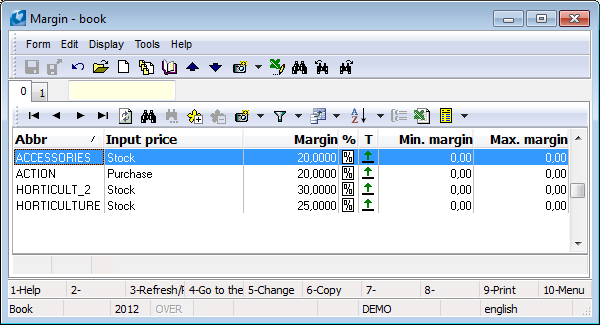
Picture: The Margin code list
Fields' Description:
Name |
Margin name. |
Input price |
An input price is a basic price which corresponds to the calculation of a selling price. You have 8 possibilities:
|
|
|
|
|
|
|
|
|
|
|
|
|
|
|
Margin |
Level of margin entered absolutely or in percent (by checking flag %). |
Margin from above |
If you count price from above, i.e. you subtract margin, you will check the field Margin from above. Example: Input price is 100 GBP and margin is 20%. If you count margin from below, than selling price is 120 GBP. If the field Margin from above checked, than the selling price 125 GBP. |
Min. margin and Max. margin |
The fields can affect some output reports. Standard IS K2 doesn't use it. |
Purchase cost |
You mark this field in case, that you want the purchase costs, inserted on the 2nd page of Article card, will be entered to calculation of selling price. |
Duty |
If you want the duty, inserted in customs tariff on the 2nd page of Article code, enter to the selling price, you will mark this field. |
Excise Tax |
This field hasn't got use in currently IS K2. |
Product groups divided database of article to the groups according to discount (sign '-') or surcharge (sign '+') to basic selling price of appropriate article. The surcharges (discounts) are given in percent of selling price.
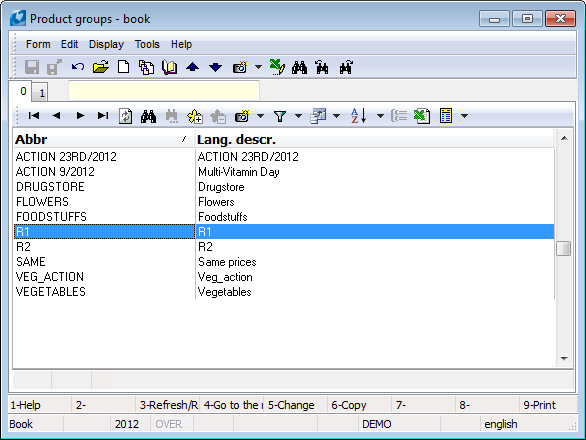
Picture: Code list Product group
You insert new product group by Ins key or F6 key. Deleting from the book Product groups isn't possible. Language Description of product group is possible to insert too.
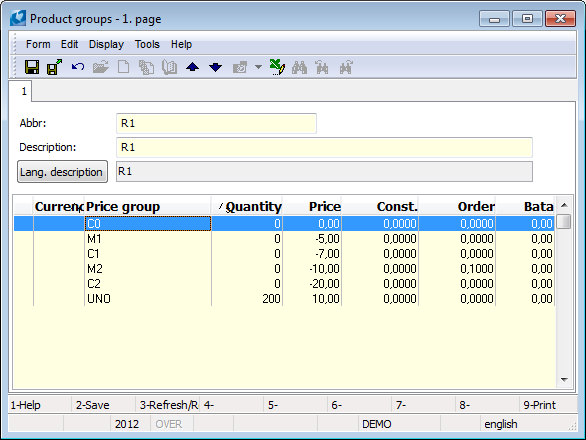
Picture: Product groups - 1st page
List of the items of concrete product group (of the particular customers and price groups with defined surcharges) is given on the 1st page. In the Change mode you can define new (by Ins key) or edit existing price groups. For deleting product group item you use key Del in Change mode.
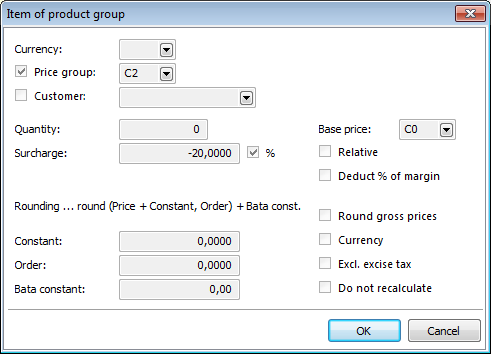
Picture: The Product group item form
Fields Description:
Currency |
By the Search field you select the currency in which the price should be counted and displayed. It is counted according to an actual rate. |
Price Grp. |
By checking the field Price group you define that the entered price will refer to a price group. Note: If you check the field Price group, the field for entering customer will be inaccessible. |
Customer |
By checking this field you define that the entered price will relate to selected customer - the so called customer price. Note: If you check the field Customer, the field for entering price group will be inaccessible. |
Quantity |
The minimum quantity of articles, from which (including) the entered price is valid. Attention: When entering the quantity is suitable to cover the whole interval, i.e. e. g. in a different price since 10 pc to create 2 records: for 0 - p and for 10 and more. Otherwise the price according to price category will be entered for less quantity. |
Surcharge |
In this field you set a surcharge amount or discounts (if you set negative sign) that will be added to the basic price. The surcharge you can set either by an absolute amount or in the percentage. |
The basic price |
If you want the price of a given price group to be based on a price of another price group, you fill this field by selecting from Prices group book. |
Relative |
By checking this field the price is zero in a current display (in a Change mode) and it is calculated according to a specified percentage or amount up to define of an article into a sale item. In this case the same field is checked when displaying the price by the Article prices form on the 5th page in the lower part of Articles card. |
Deduct % of margin |
During the turned on the option the percent of a surcharge, entered in the field Surcharge, is deducted from the selling price. It concerns only to the prices group. Example: You have a basic selling price 100 GBP and surcharge for the price group -10%. Resulting selling price for the price group than will be 90 GBP. After checking the field Deduct percent of margin the resulting price will be 90,91 GBP. (Amount 100 GBP isn't 100% but 110%). |
Rounding |
During the calculation of the price groups the programme executes rounding the prices according to the given algorithm: (Price + Constant, Order) + Baťa Note: "Price" is a selling price edited about surcharge. |
Constant |
Constant is an amount which will be ascribed to a selling price edited about a surcharge. It serves to rounding up or down (thus not mathematically). |
Order |
To the field you enter how many places you want to rounding. It is possible to enter not only the decimal numbers, but also rounding off to units, tens etc. |
Bata constant |
If you want that a resulting price ended by concrete number, you can enter amount to this field. This price ascribes to the price. Example: If you want to have the final prices set as Baťa's, that means the prices has to final by nine, than during the pricing you will enter rounding on the tens (the field Order) and to the field Baťa number "-1". Than the value "-1" will deduct to the calculated selling price. |
Round gross prices |
By checking the flag you ensure rounding a gross prices according to set algorithm, that means, set rounding in the left part of a form, relates to the gross prices. |
Currency |
By checking you enable to enter the price in foreign currency which is selected on the Article card. Recalculation between the currencies executes by a course from the Article card. |
Excl. excise tax |
Current IS K2 doesn't use the field. |
Do not recalculate |
By checking this field you set that the appropriate price should not be recalculated when price groups/customer prices recalculating. Theirs value will stay the same, the percentage of displayed surcharge will be adjusted. Check mark is transferred into the Article prices form when creating this record, a later change here and in the Article prices form will not reflected in the next - bundled form. |
By using price groups, you can divide the Suppl./Cust. database into the smaller units. Price groups differ from each other in size by price surcharge or discounts when selling the articles.
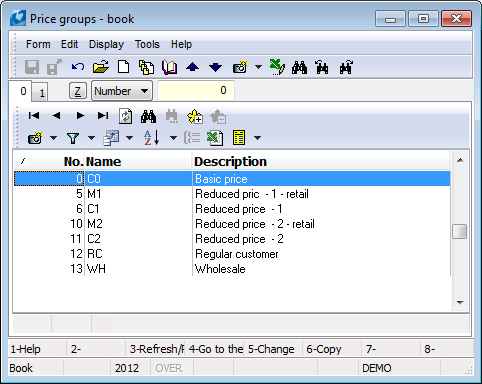
Picture: Price groups code list
You can insert new price group by using Ins or F6 key.
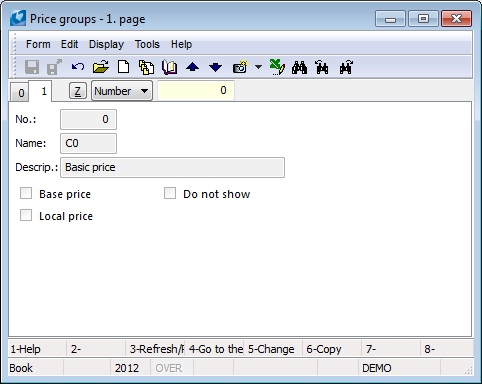
Picture: Price groups - 1st page
Fields Description:
No. |
Number of a price group, which it is necessary to enter manually. Two price groups can not have the same number. Number can not be changed additionally. Number has meaning if the client parameter Unsorted price groups (see Clients parameters (2nd page)) is not activated. |
Name |
Name of a price group. |
Description |
A brief description of a price group. |
Base price |
The price is not changed when recalculating. The field has the same function as the field Do not recalculate in the Product group item form. |
Local price |
The price is not transferred to the branches. |
Do not show |
The price group is not displayed after calling the Article prices form by pressing F7 key on the Article card. |
In the lower part of the 5th page of an Article card, there data, that relate to price groups settings, eventually to customer prices, are displayed. The prices can be set by two ways:
- By filling the Product group field in the Price list preparation form and by recalculating price groups, these prices will be automatically pasted if the option Customer prices in product group is not checked on 2nd page.
- By pressing Ins key, you call the Article prices form, where you can define the appropriate data. However, these prices can be updated only manually by calling the same form, the price recalculation does not influence them (they can just delete them).
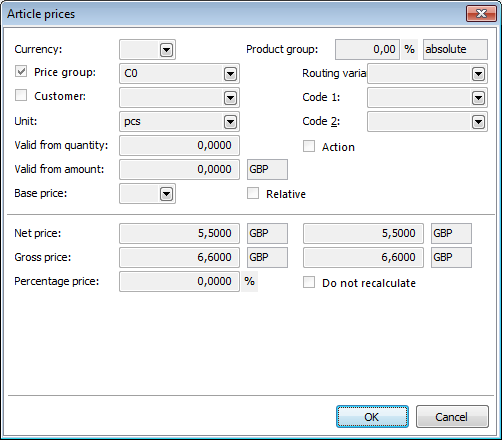
Picture: Article prices form
Fields Description:
Currency |
The currency in which the price is specified. If this currency is the same as the basic currency, it does not fill. |
Price Group |
A price group from which the price will be unfolded. If you check the field for price groups the field Customer will be inaccessible. |
Customer |
You select a costumer for who this price will be valid. If you check the field for a customer the field Price groups will be inaccessible. |
Unit |
The prices that are displayed in the lower part of the form are related to a selected unit. |
Valid from quantity |
Quantity of articles from which above (including) the price is valid. After setting an appropriate quantity the field Valid from amount will be calculated by multiplying the fields Valid from quantity and Net price. Attention: When entering the quantity is suitable to cover the whole interval, i.e. e. g. in a different price since 10 pc to create 2 records: for 0 - p and for 10 and more. Otherwise the price according to price category will be entered for less quantity. |
Valid from amount |
The field is automatically filled depending on the value of the field Valid from quantity. |
Base price |
A price group on which depends the surcharge. If the field doesn't completed, surcharge relates to a Selling price from the 5th page of the Article card. |
Actions |
This field is useless in the IS K2. |
Relative |
By checking this field you enable to calculate the price when using it. A relative price is defined by a percent of a Basic price and its concrete value (how it would be calculated at the moment) is displayed in a Browse mode. If the field is not checked, it deals with an absolute price which amount is fixed at the moment of inserting and it remains the same unless it is changed manually or calculated in bulk. |
Routing variant |
The routing variant of a product or a semi-finished product for that the price is valid. This field can serve for user identification, the standard of K2 does not work with this field when price formation and inserting prices in the documents. |
Code 1 |
Possibility of setting any code. It serves for user identification. |
Code 2 |
Possibility of setting any code. It serves for user identification. |
Net price |
Net price automatically enters after filling the field Article as a selling price from the Article card. Here it is possible to set other price than is given on the Article card. Change will take effect in the fields Valid from amount, Gross price and Percentage price. Note: If a foreign currency is entered in the field Currency, an amount in this currency is entered in the right part of the field Net price. Recalculation of the foreign currency executes according to the current exchange rate. |
Gross price |
Net price automatically enters after filling the field Article as a selling price from the Article card as well, after of adding an appropriate VAT rate. Change of Gross price will take effect in the fields Valid from amount, Gross price and Percentage price. Note: Way of display gross price corresponds with display net price. |
Percentage price |
The percentage price indicates the percentage to be added to the original selling price defined on the Article card or to the price according to the price group specified in the Basic price field. You can set the percentage price with a negative sign, the original selling price will decrease. If you set the percentage price, the field Valid from amount, Net price and Gross price will change. |
Do not recalculate |
By checking this field you set that the price will be entered manually and it should not recalculate. The price is not deleted neither in that case when price recalculation you check the Delete current price groups/customer prices field. |
There are prices whose are valid at concrete date. Date prices are defined by the same way as selling prices on the 5th page of the Article card with the difference that you enter Date (date from) and Valid to (date to) in the Price list preparation form, that means in which interval is price valid.
Except this entered interval is given by so called current prices, where date doesn't define (that means it is display in format 0.0.0000). Current price will create automatically with creating article card. This price you can only edit, not delete.
In order date price will automatically inserted to an invoice out, you need to check the field Use date prices of articles on-line in the Client parameters.
You find detail description of work with date prices in the chapter Price Creation methodology in K2 IS.
Stock turnovers (6th page)
There is an overview of the turnovers of articles by periods per specified period and per specified warehouse on the 6th page of an Article card. Selection of a displayed interval and warehouse is executed in Browse mode by pressing Alt+F10 keys. Interval and abbreviation of a warehouse will be displayed in the upper blue bar.
The summing data - op. level, turnover, balance and cl. level are displayed in the upper part of the 6th page of an Article card.

Picture: Articles - 6th page
Selected columns description:
Quantity in |
The amount of income (positive movements in receipt documents) |
Quantity in - cr. notes |
The amount of income in credit notes (negative movements in release documents) |
Quantity out |
The amount of outputs (positive movements in release documents) |
Quantity out - cr. notes |
The amount of outputs in credit notes (negative movements in receipt documents) |
Calculation of movements into the summation of turnovers in the header
The negative movement does not increase a turnover, but only decreases the appropriate page of a turnover. It follows that the credit notes of the stock documents should be used only to correct the original motion.
Movement |
Calculating into the summation of turnovers |
Receipt by a receipt card |
positive value on the receipt page |
Release by a release note |
positive value on the release page |
Receipt by a release note |
negative value on the release page |
Release by a receipt card |
negative value on the receipt page |
Suppl./cust. turnovers (7th page)
On the 7th page of Article card the suppl./cust. turnovers are displayed namely in case that the field Customer record / article record in the client parameters. Selection of displayed interval is started in Browse mode by pressing Alt+F10 key.
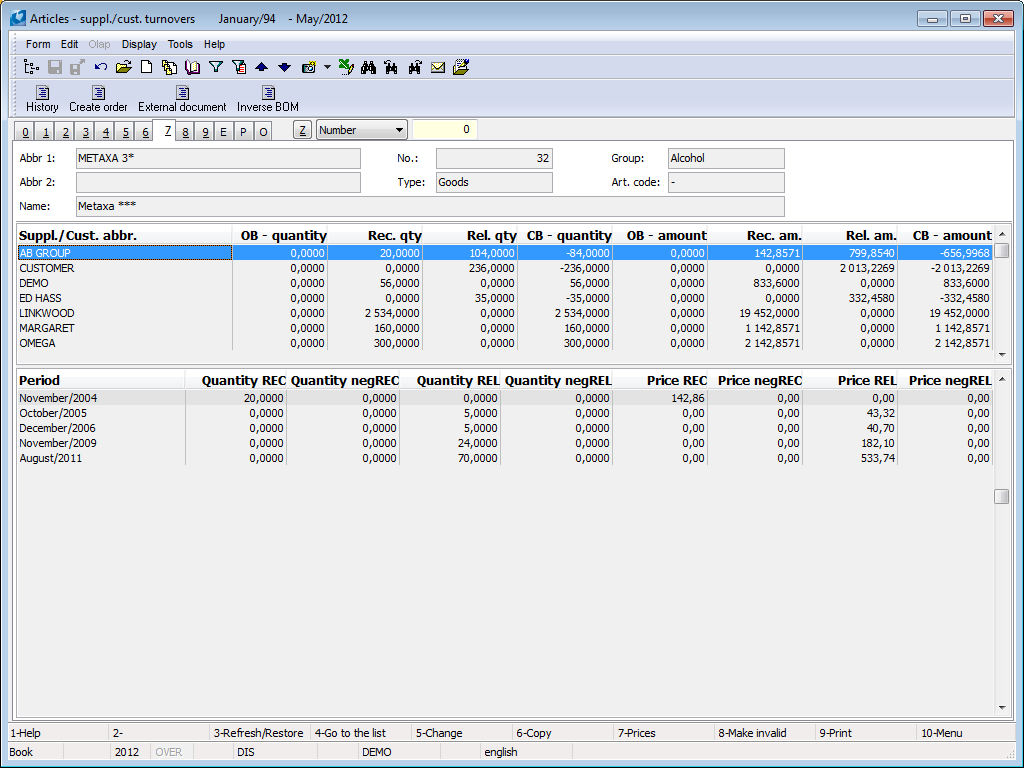
Picture: Articles - 7th page
Stock card (8th page)
Stock movements for selected period and stock are displayed on the 8th page of an Article card. They are automatically updated by a confirmation stock documents, eventually by Stock recalculation. You can change a period or a warehouse by using Alt+F10 keys.
The summing data (op. level, turnover, balance, cl. level) are displayed in the heading of a stock card.
A stock movement is realized by the following documents: Receipt card (RP), Release note (RL), Transfer note (TR), Job card (JC). It is possible to switch directly to the concrete document by pressing Enter key on the appropriate line.
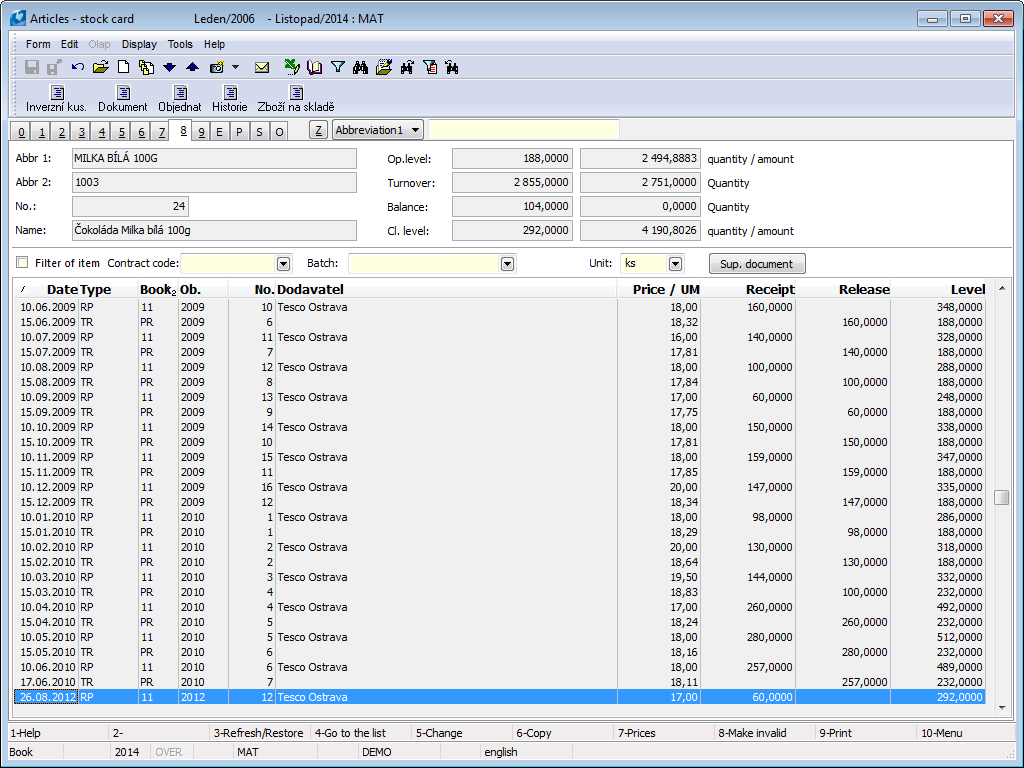
Picture: Articles - 8th page
By pressing Shift+F6 keys, you can select between displaying in quantity or in monetary amounts. The change of displaying will take effect in a header in Turnover and Balance fields and further in Receipt, Release and Level columns.
By activating the Filter of items option, you can define the filtering of documents according to the contract code or according to the batch, or by their combination. Contract code and Batch are taken from the document items that are stated on a stock card. By pressing right mouse button on Contract code and Batch fields and by using the function Copy from current row you can fill quickly the fields with values from the currently marked item (you can use it for searching e.g. related movements).
The field Unit, in which you can select the unit, in which you want to display the values, is also accessible on this page. Choose from active stock units defined at the appropriate Articles card.
By the pressing Sup. document button, you display:
- a purchase order for a receipt card,
- a sales order for a release note,
- a superior sales order or a superior job card for a job card or a transfer note.
The adding of the stock movements into the summing turnover in the heading with regards to credited items is described in the Stock turnovers (6th page) chapter.
Ext. documents (9th Page)
On 9th page of Article you can assign ext. documents or documents to an appropriate batch as in other modules. At article it can be for example connection of instruction, Declaration of conformity and other items. Further description of work with external documents is stated in the chapter Basic Code Lists and Supporting Modules K2 – 9th Page.
There is accessible the button Language name too which enables to assign descriptions in foreign languages to the Article card.
You can copy language names between individual article cards. After pressing Ctrl+F6 keys in form of language names all items will copy to clipboard and after pressing Shift+F6 keys the items of languages, which doesn't contain here, will insert from clipboard to a form
Internet shop (page E)
On the E page the data are summarized that can be used for the internet shop. Only an user sees this page who has set the Browse i-shop data right in the Rights - Other - I-shop part. Only an user who has the Change i-shop data right can change the data (Rights - Other - I-shop).

Picture: Articles - page "E"
The Availability field is a link in the code list for possibility to export to e-shops. The Class field is only displayed here, it is used on the P page and defines the list of parameters that will be displayed.
The list of trees defines to which trees the article will be added. Simultaneously the list of webs defines where you can find the article. If in the added tree or web there is the flag ![]() it means that this tree is not assigned to any web of the article card, or that this web is not used by any of assigned trees. In the both lists you can insert the new records by selecting of all valid existing by pressing Ins key, Shift+Ins key you use in that case that you want to insert only records that are related to records of the second code list of the Article card (e. g. the selection of the trees that are added to the webs records on this Article card). Inserted record you can delete by pressing of Delete key. By pressing of Enter key you can display a definition of this web that means the list of trees that are applied on the web.
it means that this tree is not assigned to any web of the article card, or that this web is not used by any of assigned trees. In the both lists you can insert the new records by selecting of all valid existing by pressing Ins key, Shift+Ins key you use in that case that you want to insert only records that are related to records of the second code list of the Article card (e. g. the selection of the trees that are added to the webs records on this Article card). Inserted record you can delete by pressing of Delete key. By pressing of Enter key you can display a definition of this web that means the list of trees that are applied on the web.
Next to the list of trees you can see the categories of a tree, that is positioned by the light indicator, where the article is added. The categories and their tree structure are created by a script. You can insert an article to this structure by the same script or from the Article card by pressing Ins key in the list of categories too. The tree structure of the actually positioned tree will be displayed, you select one category and there the articles will be inserted. You can delete a category by pressing Delete key.
Further it is possible to add a related category to the Article card, this you can use e. g. for various accumulators, electrical cables etc. With a related category you work by the same way as with the Article classification in the category.
To the article cards you can set several "marketer" flags (values) for particular webs. The Suppress option is an exception that enables to prepare all data for export to the web in the card, but to exclude this card from export. The flags will be displayed to the actual positioned web. If you can check the For all webs option, then the values are related to the all added webs. "Completed" field means in this case that the option has entered a various value for the various webs.
Articles - 12th page (P)
The page enables to register the structured information of often technical character to the Article cards - so called Parameters. Their list can be created separately for every card by Ins key, or it is possible to use predefined lists - so called Classification. This predefined list on the Article card you can arbitrarily complement by other parameters (this inserted parameter will have flag of manual insertion) but these parameters will remain on the card only in case that they will be filled a value. Every parameter on the Article card or in Classification has to have assigned Group from list of groups. On the one Article card or in one Classification the parameter can occur only once.
If you change Classification on Article card, a list of the parameters will automatically changed too. But the parameters with filled values remain as manuallz inserted.
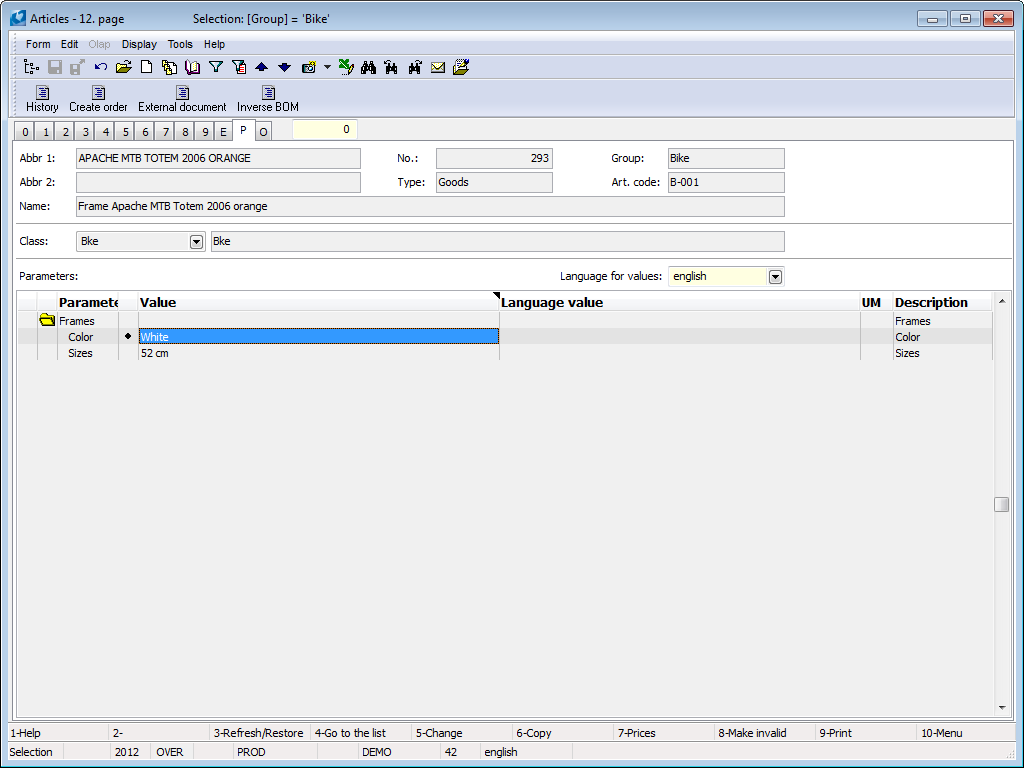
Picture: Articles - page "P"
Editing of the parameter values
The parameter values you can change by three ways:
- During the inserting of free parameter you enter the value directly in form for selection of parameter.
- You edit the particular parameters by so called line editing - in the column Value you press Enter key, you enter/select required value from the list and by Enter key you confirm entered value. At parameter with option of enumeration values the same form opens as during the inserting of parameter (point 1). In a list of the values you mark values, which are valid for appropriate goods. By pressing of the button OK you close the form. The values, selected by this way, will be displayed in the Value column one after another separated by semicolon.
- If you enter all values to the one group, you could use form for entering of more values at once. On the group you press combination of keys Shift + Enter. Form for entering of the parameter values in the group will display. Here you enter the required values directly to the fields Value to the particular parameters. In case of order (selection of a list or enumeration values) the list of predefined values you opens by F12 keys, you choose value by Enter key, the required values mark at enumeration
 and you close the list by Enter key or Tab.
and you close the list by Enter key or Tab.- Also you use this variant in case that you enter so called the comparative values at parameter or you want to change unit of parameter value.
Note: Comparative value - the parameters exist its value enough to develop that the earlier used unit subside be practical (well-arranged) and other unit states in some case. However if you want to search according this parameter, subsequently for example in I-shop, it will need that the system compare absolute value in the same unit. Example of this use are "hard drives". Previously their capacity stated in "GB" (gigabyte) but today the common capacity is in "TB" (terabyte). Therefore you state value "1 TB" to the disc and to the comparison value you write number "1000".

Picture: Form for entering of the parameter values in the group
In Class in the Change mode, it is possible to shift item (parameter or group), on which the light indicator is, by using grey + and -. The form of a parameter can be displayed either from the 1st page of the Class or in the grid on the 'P' page by using the Ctrl+Shift+Enter key combination.
By the Parameter the characteristic is register that is related to an Article card. The colour, weight, material, length, speed, Supported file formats etc. might be an example.
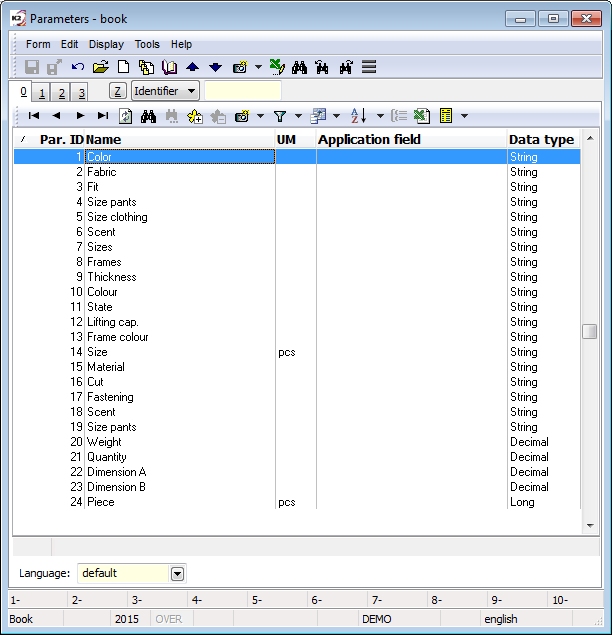
Picture: Parameters book
On the 1st page of Parameters card you can insert the basic data of a parameter (characteristics).
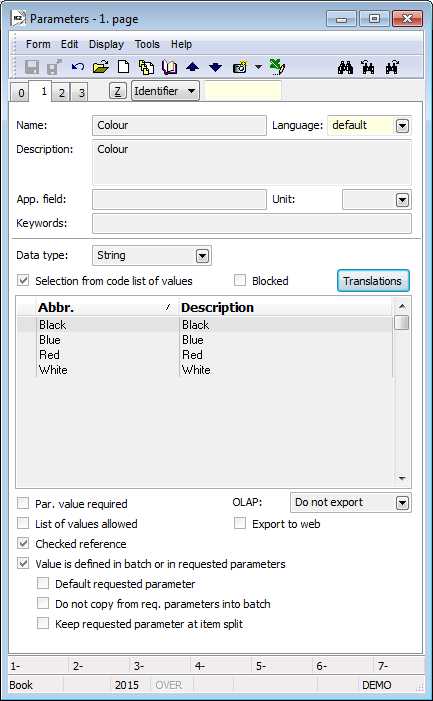
Picture: Parameter - 1st page
Fields Description:
Name |
The parameters name. |
Description |
The description that can be exported e. g. to the e-shops as a explanation of a content of a parameter. |
App. field |
A working description for a better orientation among the similar parameters, it can briefly summarize the parameter setting. |
Unit |
The link to the code list of unit parameters. If it is filled, it has to correspond to the record from a code list. |
Keywords |
For option of export to the e-shops. |
Data type |
The kind of an expected value. Text, Integer number, Decimal number, Date, Time, Field from article card are offered. If the number is selected, the next field is displayed where you can define a number format. In the case of the Field from article card option the next field will be displayed too, where you have to select to which field or note the parameter will refer from an Article card. You can use a linkage field too, in this case the link is indicated by semicolon. The link to a note type is written as "P@type" of a note, also e. g. to a business text you link by "P@DH". |
Selection from code list of values |
The option provide a possibility to display to an user the list of predefined values. |
Par. value required |
If a parameter is obligatory, the Article card, where this parameter is inserted by the Classification, can not be saved without filling of a parameter value. This applies only to users who have the right to fill in the parameter values??. |
Value is defined in batch or in requested parameters |
By this option, it is not allowed to define parameter values on the "P" page. For distinguishing the particular deliveries of articles or production lots, enter values directly in batches. Parameter is not valid for Articles in general. Batch type is also internally saved in batch. Class, with the parameters including "Value is defined in batch or in requested parameters" flag, will be generated with new batch type when each relevant change of Class (i.e. items), or parameters (flag, data type). Without this flag, the old batches would report inconsistency in this case. |
Default requested parameter |
Parameter with this option will be implicitly inserted when newly created requested parameter on purchase/sale item on Parameters tab. This option is active only if the Value is defined in batch or in requested parameters option is checked. |
Do not copy from req. parameters into batch |
Parameter with this option will not be transferred from the requested parameters into the batch when its creating (e.g. by confirmation a receipt card) and it will not be displayed on "P" page. This option is active only if the Value is defined in batch or in requested parameters option is checked. This parameter can be used as auxiliary parameter when definition of multidimensional quantity. |
Keep requested parameter at item split |
This option of parameter causes, that at purchase/sale item split, the value are copied into a newly created set of the requested parameters. It is recommended to check this option for the parameters, values of which we do not want to loose at item split. Vice versa at the parameters, that expressly require the new entering of values when splitting an item, this option may not be checked, but we recommend for such a parameter check the Par. value required option, so that the document with the empty value will not be confirmed when the new value will not be entered. |
List of values allowed |
It enables to select and mark more values, that the Article card fulfils, from the list of predefined values. This possibility is useful e. g. if you want to create for cameras the list of supported picture formats. In the predefined values you define all known and used picture formats and then at a concrete camera you mark all these that the camera can create or process. |
Checked reference |
It solves the possibility for users to write another than predefined value, in a selection from the predefined values. In the case of enumeration the control is obligatory, that means it is possible to select values only from the list. |
Export to web |
It serves for ignore or placing of a parameter in the export to the e-shops. |
OLAP |
Option enables to export the parameter values as OLAP dimensions. |
On this page of a parameter the overview of groups is displayed where a parameter is saved as a predefined.
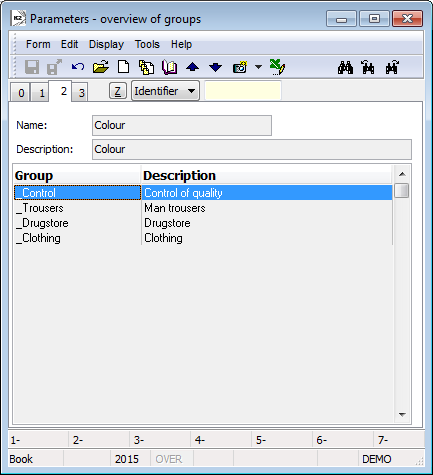
Picture: Parameters - 2nd page
On this page of the parameter the list Classification is displayed where the parameter is saved as predefined.
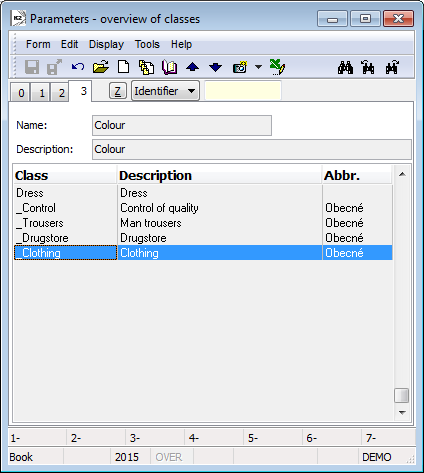
Picture: Parameter - 3rd page
Parameters groups have got double meaning. It enables to sort the list of the parameters in the Classification or on the Article card how they belong together. In this case you insert parameter and then you choose an appropriate group.
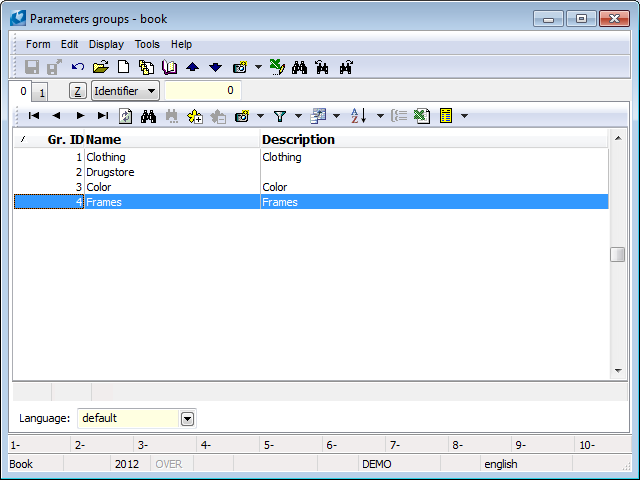
Picture: Parameters groups book
The second option is use meaning of group which you often use for the same parameters list. For example group Packaging always contains the same parameters: English instructions (yes/no); Size of the box (small, middle, large); Content of packaging (text string for listing the content). During the setting up of the group you directly add these parameters to the group. Any time in the Classification you want to describe package, you insert all group with predefined parameters.
You insert the parameters to the list by Ins key, you delete by Delete key. You can edit an order of the parameters by Gray Plus (numeric keyboard +) and Gray Minus (numeric keyboard -). On the parameters used in the group than an appropriate group will be visible on the 2nd page. Updating the parameters list in the group doesn't show in the existing classifications.
Class serves for predefining parameters list, its sorting to the groups and determining order, in which they will be display. You can use the predefined classification on a random number of the article cards.
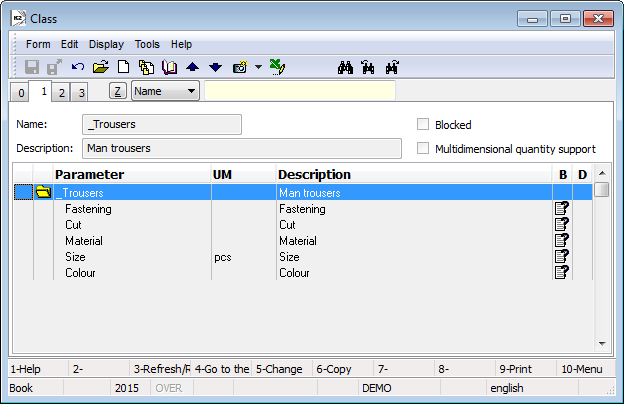
Picture: Class - 1st page
To a table you insert parameters list. Parameters are divided to the groups (marked ![]() ). Two options are available:
). Two options are available:
- You can insert them one by one by Ins key - to select parameter, to assign group to it and insert to the list by OK button.
- The second option of using the predefined lists of the parameters in the groups - if you press Shift+Ins keys, from the list of the groups you will choose the one and this you will insert to the Class. The group will insert with all its predefined parameters. You cannot observe order of the parameters and group content. Groups serve only for simplified inserting.
You can randomly delete the parameters by Delete key. By the same way you can delete whole group - if you press Delete key when the light indicator is on the group. You can randomly edit an order of the parameters by Gray Plus (numeric keyboard +) and Gray Minus (numeric keyboard -). Later change of the classification will display to the article cards where the classification is used.
Evaluation (page V)
On the particular tabs, the user finds a diverse evaluation of the Article card from perspective of logistics.
The tab includes following subtabs:
- Daily stock: it is displayed if the user has set the right Code lists / Articles / Display daily overviews.
- Inventory turnover: it is displayed if the user has set the right Code lists / Articles / Display Inventory turnover.
- ABC analyses: it is displayed if the user has set the right Code lists / ABC analyses / Browse ABC analyses.
If the user has not any from those rights, "V" page is not displayed.
Daily levels of articles for the selected period and warehouse (Alt+F10) are displayed in a chart on this tab. Daily balances of articles on stocks are calculated by the Stock recalculation function. Except displaying the inventory, it is possible to activate the displaying of other preset series in a chart:
- Sales: it displays daily values of sales. Loading is executed from the items of confirmed release notes of the currently set warehouse, the determinative date for the adding into the time dimension is a confirmation date of a release note.
- Consumption in production: it displays the daily value of the consumption in production. Loading is executed from the items of confirmed job cards of the currently set warehouse, the determinative date for the adding into the time dimension is a confirmation date of a job card.
- Minimum level, Maximum level: it displays the set minimum and maximum of the inventory for the specified warehouse or period.
All values can be displayed either in quantity or in amounts. If you want to show the values in amount, check the Show in amounts option.
Note: Negative levels of inventory are represented by the light red colour.
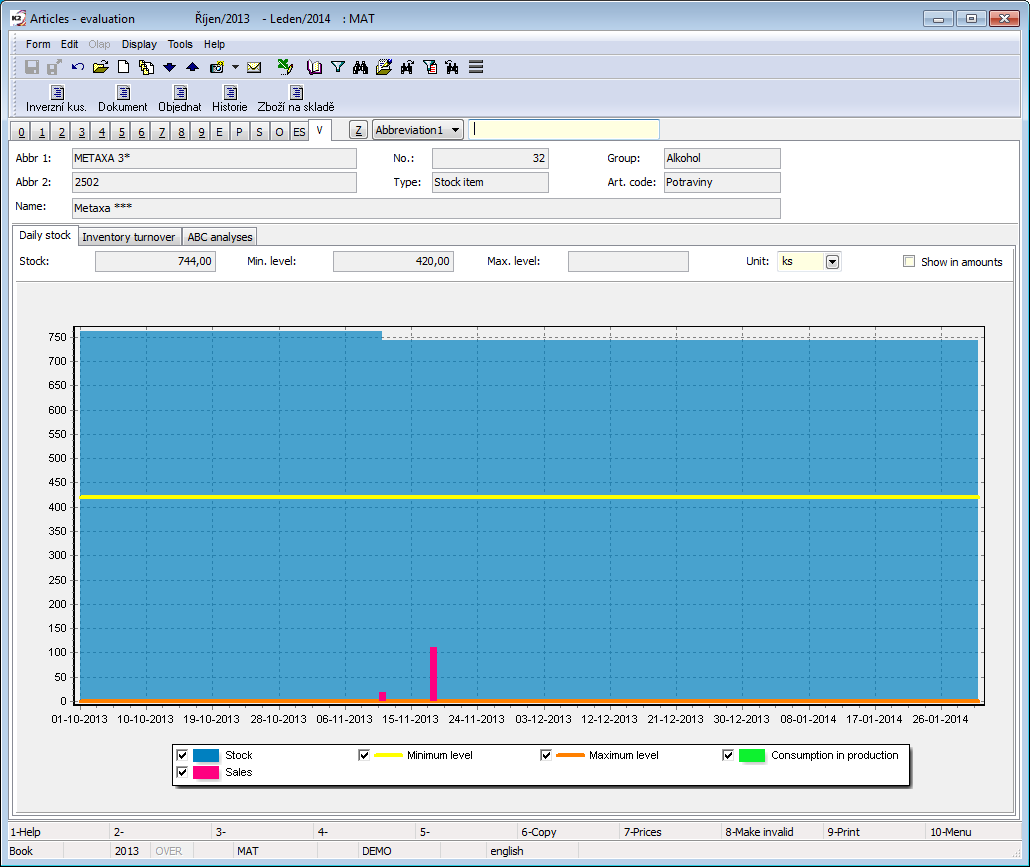
Picture: Articles - V page - Daily stock
On this tab, you can find information about Inventory turnover or about days sales of inventory (DSI).
Turnover ratio
It indicates, how many times the average inventory will be turned in the given period (period is set in Configuration). Turnover ratio is calculated as Sale / Average inventory.
Days sales of inventory (stock days)
It indicates, how long (how many days) does one inventory turnover take, or how long does the average inventory lie in a stock. DSI (stock days) is calculated as Length of period / Turnover ratio.
User finds these information on the tab:
- In the header, you can define required min. and max. turnover and the value of turnover from the last calculated default configuration is saved into the Current field. Default configuration of inventory turnover can be set by using button
 (if the user has set the right Code lists / Articles / Select inventory turnover configuration).
(if the user has set the right Code lists / Articles / Select inventory turnover configuration). - Records of the last calculated inventory turnovers of individual configurations are displayed in the table. All information, that are needed for inventory turnover calculation, are available for user: Turnover in quantity, Turnover in stock price, Turnover in selling price, Turnover ratio, DSI (stock days) and Profit too.
- In the bottom part, trend of the particular values during the history of calculation is displayed in a chart. You can select displayed value by Display option. If value of turnover ratio is displayed, then the series of minimum and maximum are also displayed in the case of the setting of minimum and maximum inventory turnover. If you want to monitor or compare values for more configurations in a chart, indicate individual records in a table by asterisks.
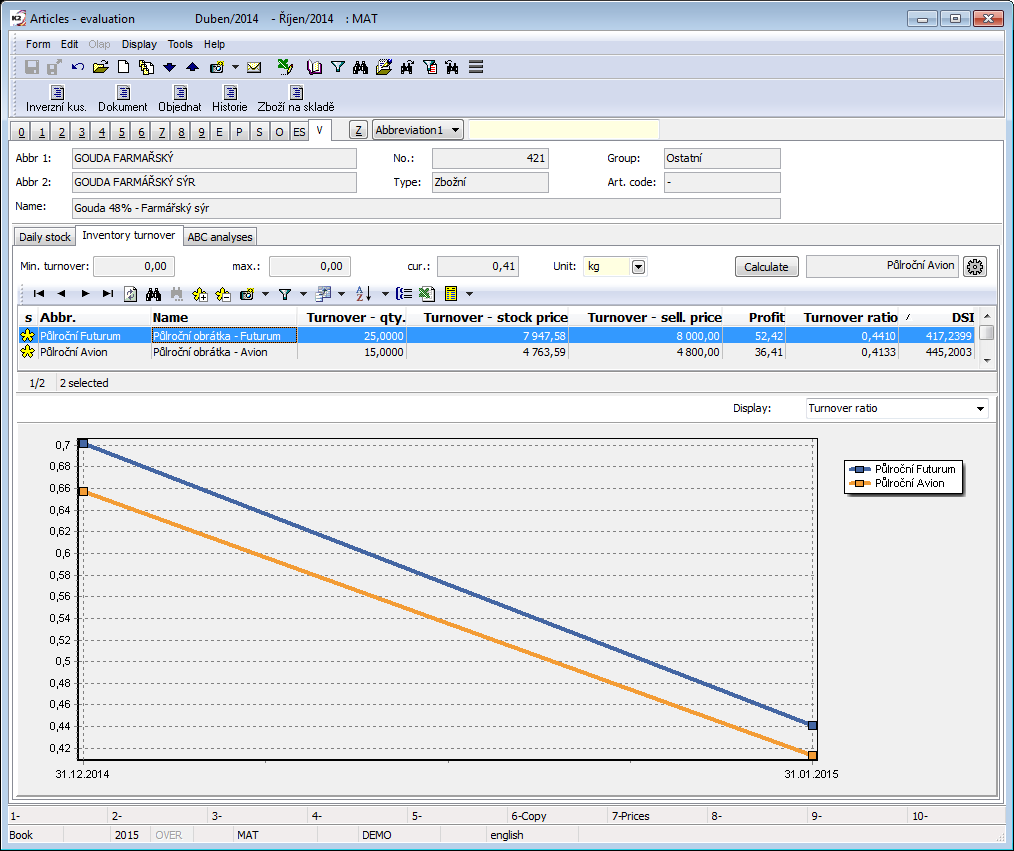
Picture: Articles - V page - Inventory turnover
Inventory turnover configuration
List of configurations is called by the button ![]() .
.

Picture: Inventory turnover configuration
Fields Description:
Abbr., Name |
Identification of configuration, obligatory abbreviation and name. |
Period type Period count |
These fields determine per how long period the data for the value calculation on the date of turnover calculation are loaded. Note: The date on which the inventory turnover is calculated, can be set in turnover calculation. |
Selection |
Selection into Sale items for determining the range of data (items, that will be processed). It is not necessary to set the selection. If the selection is not selected, items from the confirmed release notes for the appropriate warehouse (set in the Warehouse field) are loaded. |
Date field |
Date field according to which the time competence of the record will be determined. If the selection is not specified, then the confirmation date of release note ("DatP" field) is automatically evaluated. If the selection is specified, the user has to choose some date field. |
Warehouse |
Warehouse, which we calculate the inventory turnover for. |
Calculate in stock prices |
When activating this option, turnover ratio will not be calculated from quantitative values but from stock prices (Turnover in stock prices / Average accounting value of inventory). |
Last calculation |
The last date, on which the given configuration has been calculated, is displayed here. |
Verify SQL query |
It verifies the validity of configuration settings - specifically, whether the valid date field is defined in the case of specifying the selection. |
Calculation
Inventory turnover calculation is run from Form / Action / Calculate inventory turnover menu. Calculation always processes all Articles cards.
It is possible to execute two categories of calculation with regard to a count of recurrence:
- Calculation with recurrence, that ensures recurrent calculation to different deadlines. Example: once a year you will calculate inventory turnover for individual months.
- Non-recurring calculation for one required deadline. Example: at beginning of each month you will calculate inventory turnover for the previous month.
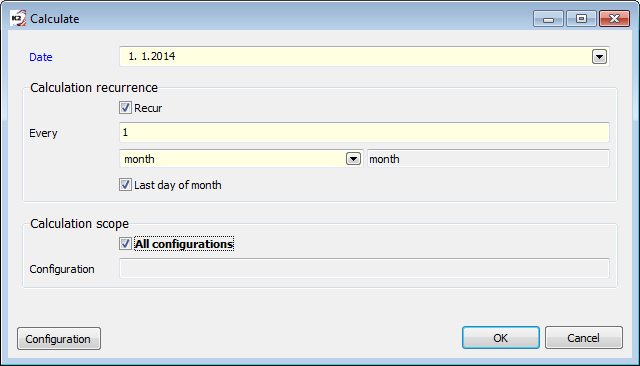
Picture: Calculate inventory turnover
Fields Description:
Date |
The date on which the inventory turnover will be calculated. In the case of calculation with recurrence, it is setting of the date of the first calculation. If Last day of month option is activated when setting of calculation recurrence, then the specified day is ignored, only the month and year are taken account. |
|
Calculation recurrence |
Recur |
Setting of Calculation recurrence. The first calculation of turnover is performed on the specified date, the last calculation then on the last possible date before the actual start date. |
|
Every |
Here define the frequency of recurrence. It is possible to choose day, week, month as the period type. |
|
Last day of month |
It determines that the turnover is always calculated on the last day of month. Example: We calculate (annual) turnover and we always want to have it on the last day of month. Set the date 01/01/2014. Set the recurrence to 1 month. Activate this option. The first calculation will be performed on the day 31/01/2014, the second on the day 28/02/2014, etc. |
Calculation scope |
All configurations |
If this option is activated, all configurations will be calculated. |
|
Configuration |
By using Configuration button (in the bottom part of the form) it is possible to select the list of configurations for the calculation. |
It contains information resulting from ABC analyses calculation.
- There is list of all calculated configurations of the current analyses in the table.
- There is ABC class field in the header panel. For saving the appropriate ABC class to theArticle card, it is necessary to set default configuration. You can set this configuration on this tab by using the button
 (if the user has set the right Code lists / ABC analyses / Select ABC analyses configuration). In this case, class from the current (the last calculated) default analysis is saved into the header of article.
(if the user has set the right Code lists / ABC analyses / Select ABC analyses configuration). In this case, class from the current (the last calculated) default analysis is saved into the header of article. - If Redefine ABC class option is not activated on the Article card, the resulting class is entered into the next field too. This field may be redefined to another class by the user (e.g. because of an assortment, because of a target where we want the article belongs to, etc.). In this case it is not overwritten when calculating.
- There is a chart displaying a history of trend of monitored value for the currently marked configuration in the bottom part. If you want to monitor or compare trend for more configurations, indicate these requested by asterisks in the table.
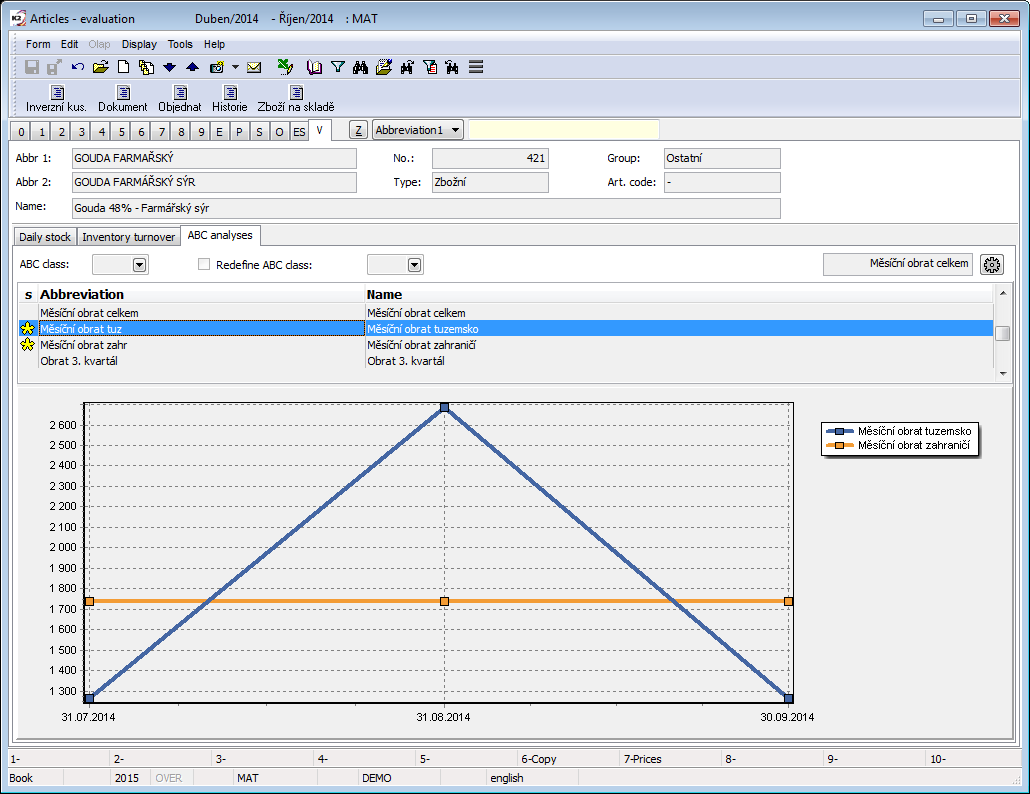
Picture: Articles - V page - ABC analyses
Articles - Complaints and service (page S)
There are records of service sheets, defects, service operations, which are issued for this article, on the 'S' page of the Article card.

Picture: Articles - page "S"
Fields Description:
Service card |
An assigned article card, which has a defined variant of routings of product repair. |
Service classification |
An assigned service classification with parameters, which will be in the Parameters tab on the service sheet. |
Guarantee for final customer: |
Length of guarantee period. If a customer has not a filled Id-No. on the Suppl./Cust. card, this length of a guarantee period is preset into the sales items and then it serves to take account of a type of service (Warranty/Post warranty) in the case of a creating a service sheet over a sale item. |
Guarantee for firms: |
Length of guarantee period. If a customer has a filled Id-No. on the Suppl./Cust. card, this length of a guarantee period is preset into the sales items and then it serves to take account of a type of service (Warranty/Post warranty) in the case of a creating a service sheet over a sale item. |
Articles - view (page O)
If you check field Display page O - Olap views in User parameters, than on the "O" page you could create views in OLAP serves to evaluation of data IS K2.
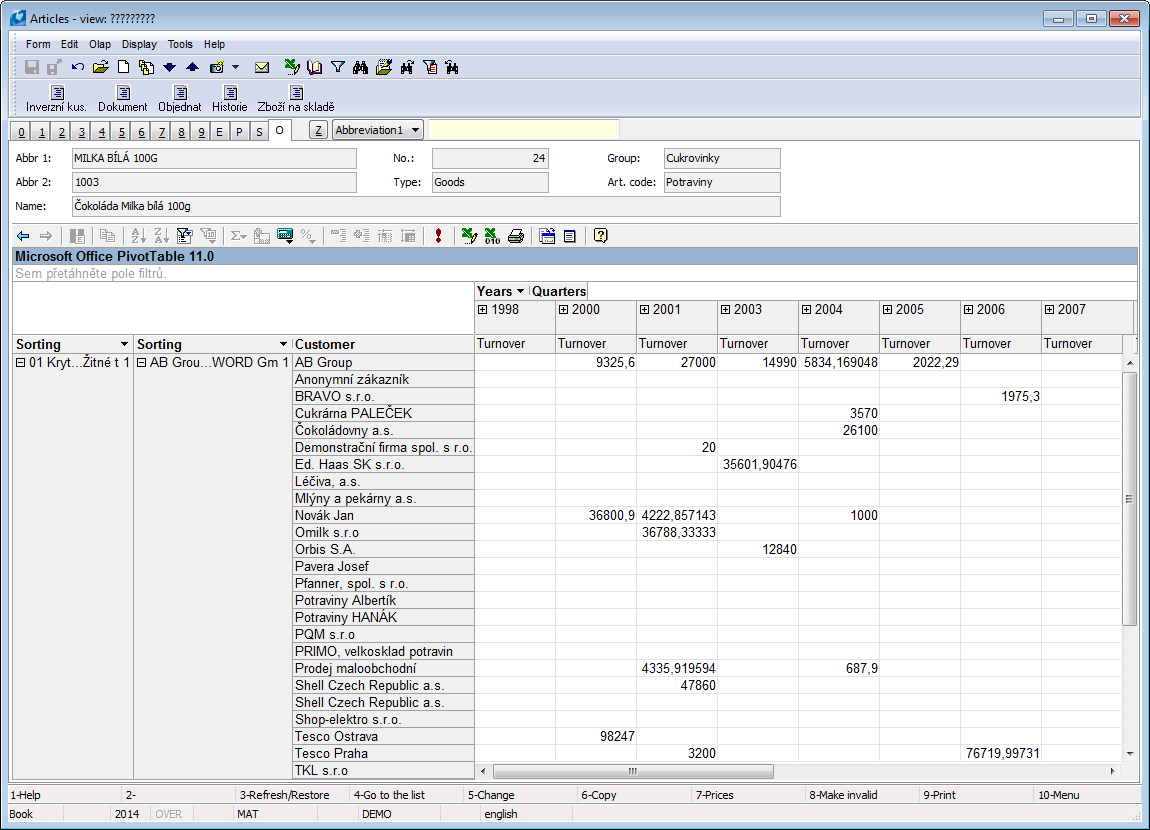
Picture: Articles - page "O"
Articles - page "ES"
On "ES" page, there are displayed and defined data about articles, that are used for K2 I-shop.
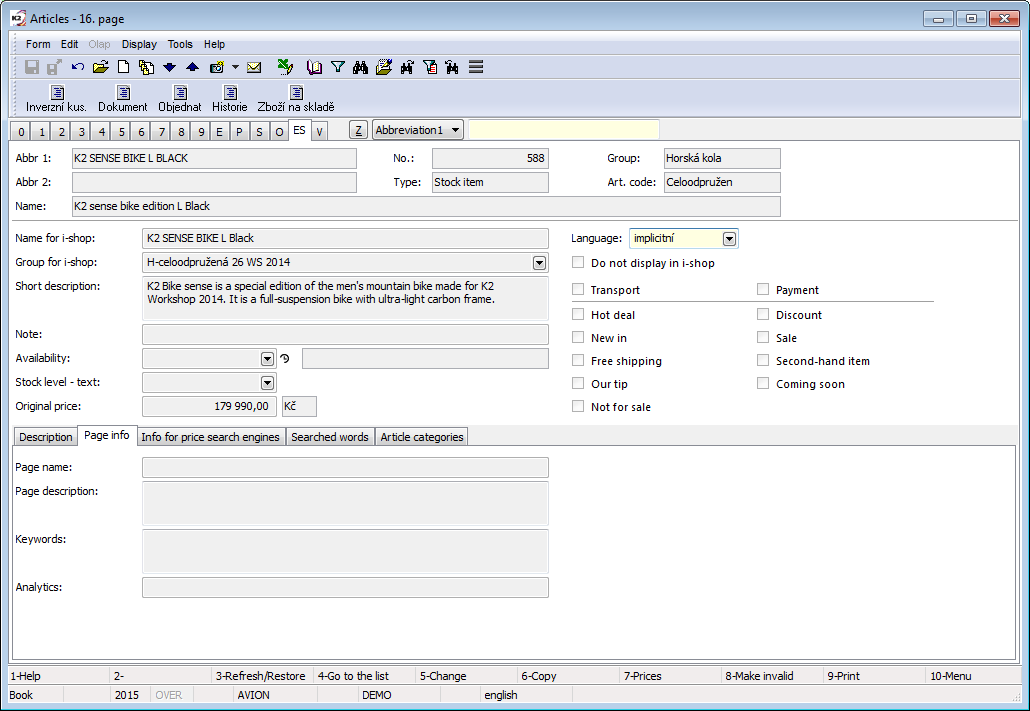
Picture: Page ES
Fields Description:
Name for i-shop |
Unique article name, by which the article will be called in i-shop. |
Group for i-shop |
Article group to assign the article into i-shop. |
Short description |
Article description, which is displayed in detail and in catalogue of articles directly under the article name. |
Note |
Note - it is not published. |
Availability |
Count of days, that will be displayed in the case, that the article is not available. Only record from the Availability book, which has the entered delivery time in days (Availability field) will be used in a web shop. If the term is not entered, "On the way" text or icon is displayed for the given article. |
Stock level - text |
Text definition, which should be displayed in specific stock level. It is possible to suppress the texts in bulk by checking the Display real stock levels check box in a web shop settings. |
Original price |
Original price entered in this field is displayed/hide in the article detail in dependence on the flag Display "original price" in Web shop setting - Article catalogue. Price is entered without VAT, in web shop it is displayed according to the setting of displaying prices with tax or without tax. |
Language |
Fields language, for which the whole text and values are entered. |
Do not show in i-shop |
If it is checked, the article will not be displayed on i-shop after recalculations. |
Transport |
Check this field in the case, when it is the Article card representing transport. The designation allows not to transfer the cards in order created as a copy of another order - then transferred only cards of Articles. |
Payment |
Check this field in the case, when it is the Article card representing payment. The designation allows not to transfer the cards in order created as a copy of another order - then transferred only cards of Articles. |
Hot deal |
Icon for Articles in hot deal will be displayed in i-shop. |
New in |
Icon for New in is displayed in i-shop. |
Free shipping |
Icon for article with Free shipping will be displayed in i-shop. |
Our tip |
Our tip icon is displayed for this article in i-shop. |
Not for sale |
Icon, that the article is not for sale, is displayed in i-shop. |
Discount |
Icon, that there is the discount on the given article, is displayed in i-shop. |
Sale |
Icon, that the given article is on sale, is displayed in i-shop. |
Second-hand item |
Icon, that it is the second-hand article, is displayed in i-shop. |
Coming soon |
Icon for article, that will be assigned to the offer of i-shop, is displayed in i-shop. It will be probably combined with Not for sale option. |
There are several subtabs in the bottom part of this page:
Description tab contains text, that is displayed on the separate Description tab, with Detail description of article title.
Page infotab contains data, that will be included in page code. It is not implemented yet.
Info for price search enginedtab contains data needed to make active use of information from the i-shop in various search engines and price comparators.
Searched wordstab contains passwords that are associated with the article and by which the customer can search the i-shop. This may be eg. a colloquial name, common misspellings customer, but also be text 1 + 1 free, etc.
It is possible to assign article to category on the Article categories tab. When the article is situated in Group for i-shop, category, where the group is used, is added automatically. Record added here by using the Ins key, is in the table marked by an icon manual editing ![]() .
.
On Flags for i-shops tab, you can set the flags Hide on i-shop (article is not loaded into the tables EsGoods and EsGoodsPrice after recalculation, then it is not available on i-shop), New in, Hot deal, Discount, Sale, Free shipping, Tip, Coming soon, Second-hand, Not for sale (article can not be added to basket) and Sale for registered (only registered user can add the article to the basket). There are also sets the Default category, which is to be displayed if the article are situated in more than one category of the same i-shop. All of these symptoms can be set for individual transactions manually using line editing, or you can use the button Sett for all i-shops where the entered values ??set in all rows. We can also take advantage of bulk action Internet shop - ES page, which will enable flags set above the filter articles for specific and for all i-shops. New row can not be inserted here manually - records are created automatically for all i-shops, in category of which the article is assigned (manually or through groups).
In the "Alternate texts for stock levels" code list, there the texts for different stock availabilities are defined.
Picture: A list of alternate texts for stock levels
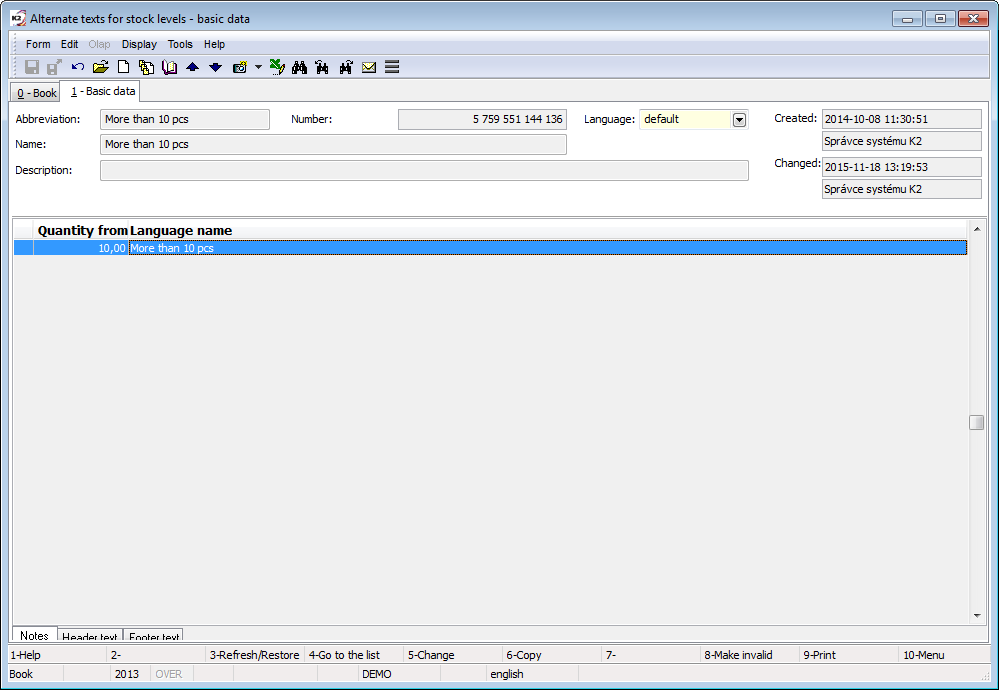
Picture: Alternate texts for stock levels - basic data
Fields Description:
Abbreviation |
Abbreviation of a text |
No. |
Record number |
Language |
Language of fields' texts |
Name |
Name |
Description |
Description |
Items
Items for stock level text are inserted to the bottom grid on the 1st page. Here, you can define, from that stock availability the specific text should be displayed.
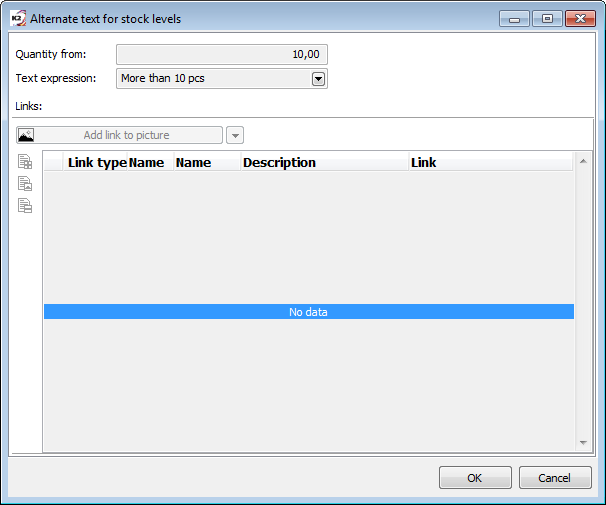
Picture: Alternate texts for stock levels - basic data - item
Fields Description:
Quantity from |
The definition of a stock availability, from that the text on i-shop should be displayed. |
Text expression |
Text that is displayed on i-shop |
Functions over Articles database
Functions description:
F7 |
Displaying the prices of the concrete article for individual price groups in the Article prices form in Browse mode. You can select a customer who customer prices should be displayed for. The function reflects neither the data prices nor the checked option Customer prices in product group. |
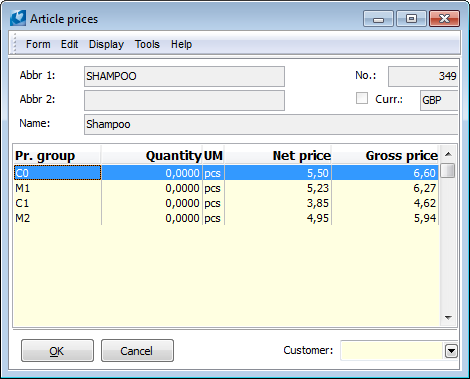
Picture: Article prices form
F8 |
The function for making a record invalid/valid. Making records invalid means that in the Book state, the cards are not visible and are accessible only in Evaluation filter off on on. A red check mark is visible on the 1st page of the card on the right side next to the Abbr 1 field. |
Alt+F3 |
Displaying an implicit variant of a routing. |
Alt+F10 |
On 0th, 6th, 8th page, there the Set period and stock form, in which you define a Period and a Warehouse, is displayed. On the 7th page in the Browse mode, there the Set period and stock form, in which you define a period, is displayed. |
Ctrl+Enter |
The 1st page of the Suppl./Cust. card will be displayed on the 4th page in the Browse mode. |
Ctrl+F3 |
If the Location record is checked (the field on 1st page of the Articles card), the overview of a concrete Article according to the Location on a selected Warehouse will be displayed on the 0th page. |

Picture: The Location book
Ctrl+F4 |
If the Batch records is checked (the field on the 1st page of the Articles card), the Batches book, in which an overview of the individual batches, which are registered at articles, on a defined Warehouse is shown, is displayed on the 1st page. |
Ctrl+F5 |
If the Contract code record is checked (the field on 1st page of the Articles card), the overview of the individual contract codes of a concrete article on the selected warehouse will be displayed on the 0th page. |
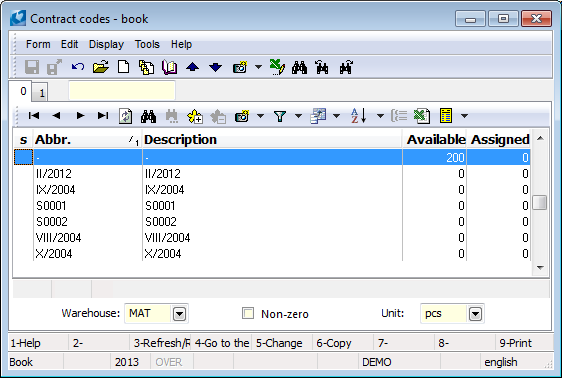
Picture: The Contract codes code list
Ctrl+F6 |
On the zero page, it calls Article wizard, which displays the status of the article on a stock in the decomposition on the Auxiliary Stock Records - a Batch, a Contract Code, a Location. |
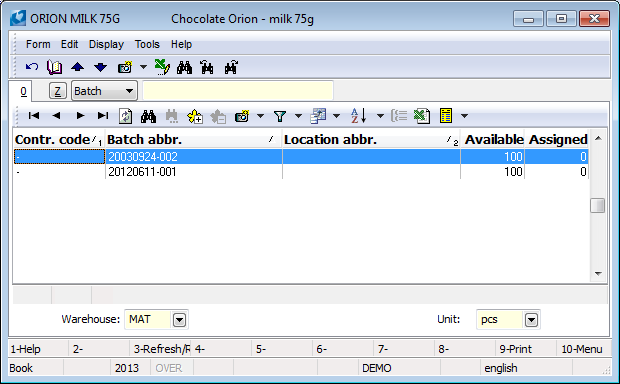
Picture: Wizard
If you call a Wizard form from the document item (by using ![]() button next to the Batch, Contract code, Location fields), the whole combination of contract code, batch and location will be inserted into the item together by confirmation of the selected row. If we use the Release entire avail. quantity button, then the whole availability of the specified combination will be entered into an item. If we use this function in the purchase item, then a flag of negative quantity will be automatically entered.
button next to the Batch, Contract code, Location fields), the whole combination of contract code, batch and location will be inserted into the item together by confirmation of the selected row. If we use the Release entire avail. quantity button, then the whole availability of the specified combination will be entered into an item. If we use this function in the purchase item, then a flag of negative quantity will be automatically entered.
Ctrl+F7 |
The Serial numbers in stock book for a current article is activated on the 0th page. The history of a serial number is displayed on the 1-History tab. |
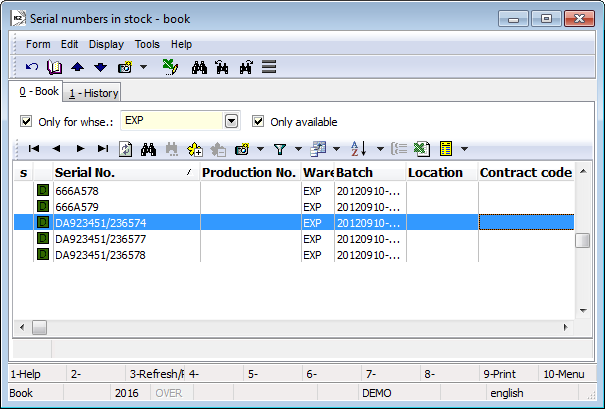
Picture: The Serial numbers in stock form
Shift+F2 |
It calls the Dispatcher function on the 0th page. Further description is stated in the Production - Planning and production supply - Dispatcher chapter. |
|
Shift+F4
|
On the 0th page, it activates the BOM decomposition function, which serves for creating a filter of items from a product routing. The items, according to the conditions entered in the form, are filled into a filter. At least one field from the fields Obligatory items, Supplements or Substitutions have to be activated. |
|
Routing variant |
Selection of a routing variant. |
|
Filter of categories |
It limits a BOM decomposition only to entered categories. |
|
Categories |
After pressing this button, the Article categories book, where by using Ins key, you can enter the article categories, which you want to display in the evaluation filter of article, will be open. |
|
Obligatory items |
All items from a routing, besides the substitutions and supplements, will be added into the evaluation filter of article. |
|
Supplements |
Supplements will be added into the evaluation filter of articles. |
|
Substitutions |
Substitutions will be added into the evaluation filter of articles. |
|
Go through all levels |
It will go through all levels of a routing, it means routing of subassemblies too. |
|
Products and subassemblies |
Apart from inputs, also product and subassemblies will be added into a filter of articles. Otherwise, only inputs will be added. |
|
Add to filter |
It adds articles compliant to the specified parameters into the existing filter. |
|
Create filter |
It creates a new filter with the articles compliant to the specified conditions. |
|
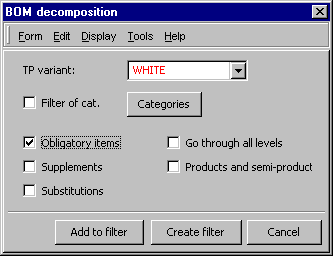
Picture: The BOM decomposition form - Shift+F4
Shift+F5 |
On the 0th page, there the Coverage of an Article demanded for individual firms (customers (on the 1st page)) and for the individual warehouses (2nd page) is displayed (see the Coverage of article demanded subchapter). |
Shift+F6 |
This key combination switches the displaying of the Amount and the Quantity on the 8th page of the Articles book (see the stock card). |
Shift+F7 |
The Stock levels form and the information about where (on which Warehouse) and in what quantity the currently marked article is located, are displayed on the 0th page. In the Article book, there you can also change position by pressing Grey Plus and Grey minus keys as well. If you mark a row with a different Warehouse than it is displayed in the Articles book, after pressing the Enter key, you will switch to this Warehouse. For better orientation, you can also sort the Warehouses according to their abbreviations. |
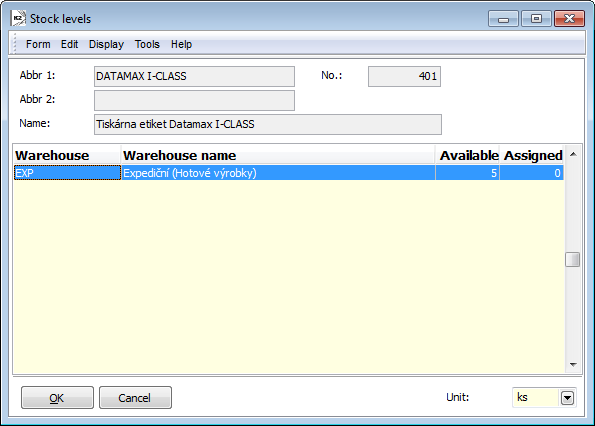
Picture: The Stock levels form
Shift+F10 |
It will call the User sorting book. It displays the selection of options for displaying of individual documents on the 6th and 7th page of the Article card. |
Alt+Shift+F4 |
A filtering of properties of individual batch types (see the Articles - Batches chapter). |
Ctrl+Shift+F4 |
A filtering of properties of batches of the selected Article (see the Articles - Batches chapter). |
Alt+Ctrl+Shift+F4 |
Properties of the search batches over the whole Articles database (see the Articles - Batches chapter). |
Ctrl+Alt+F5 |
The function enables to select Status of an article card. |
Functions of the Articles module menu
Form - Bulk actions
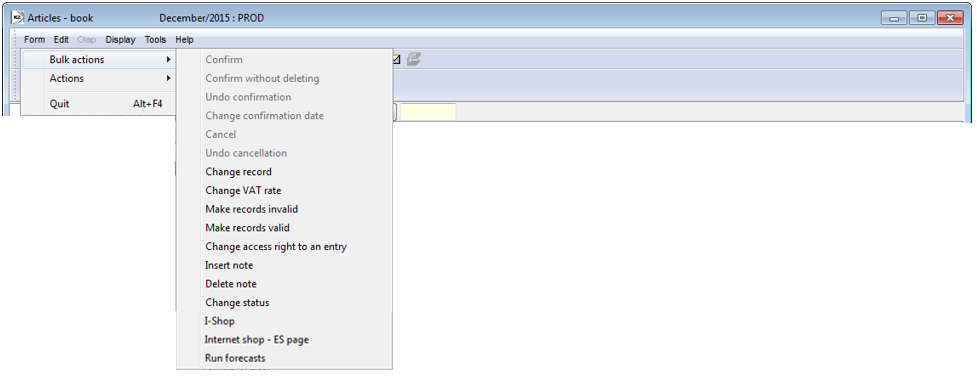
Picture: Form - Bulk actions - Articles module menu functions
The bulk actions work only over the activated evaluation filter or over the records marked by asterisks.
Actions description:
Change record |
It enables the bulk change of data of the 1st and 2nd page of the selected articles cards. Check the fields, which you want to change, in Bulk change of articles form. For every selected field, set a value, which you want to have defined on an individual articles cards. The checked option Delete from filter performs deleting records from filter after launching this action. |

Picture: The Bulk change of articles form - 1st page
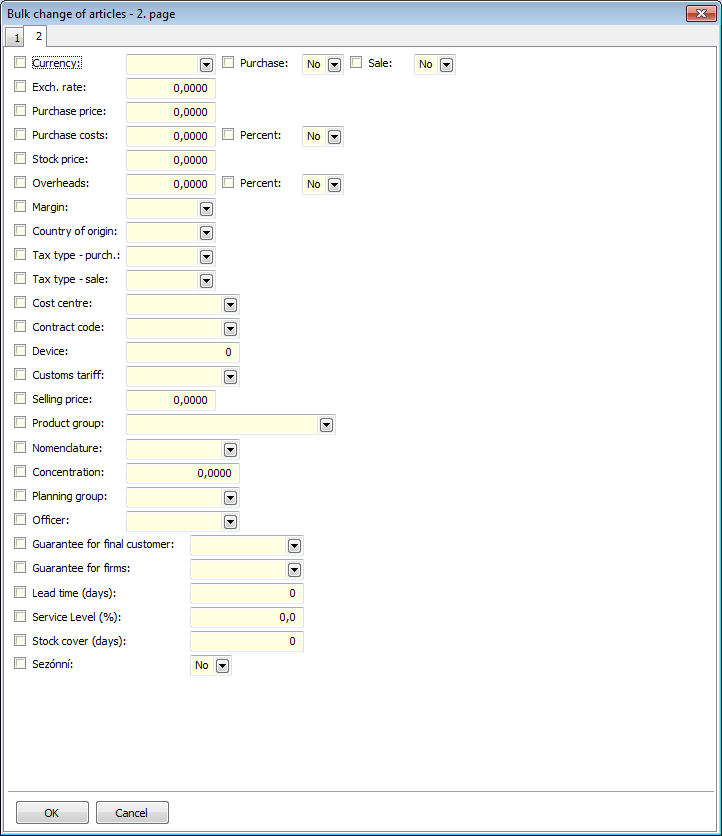
Picture: The Bulk change of articles form - 2nd page
Change VAT rate |
This function enables to change a VAT rate on the Article card with a validity from a specific date.
Picture: The Change VAT rate form |
Make records invalid |
Function for a bulk making records invalid with a simultaneous deleting the records from filter. |
Make records valid |
Function for a bulk making records valid with a simultaneous deleting the records from filter. |
Change access right to an entry |
Assignment of the group of rights for browsing and changing the selected cards. These cards can be browsed and changed only by the users who have been assigned to the appropriate group of rights. Other users see only crosses instead of cards. The access rights to an entry are assigned on 4th page of the Users book. |
Insert note |
It adds a note of the same type into the selected records. It simultaneously executes a deleting the records from a filter. Notes are selected from the Kinds of notes book. |
Delete note |
It performs deleting the selected notes from the selected records. The further description is stated in the Basic functions - Module Menu Functions - Form chapter. |
Change status |
It enables the bulk change of the Status field at the selected records. |
I-shop |
It enables the bulk change of data of the "E" page of the selected articles cards. Check the fields, which you want to change, in the Change Internet shop parameters form. For every selected field, set a value, which you want to have defined on an individual Articles cards or which you want to remove from the cards. |
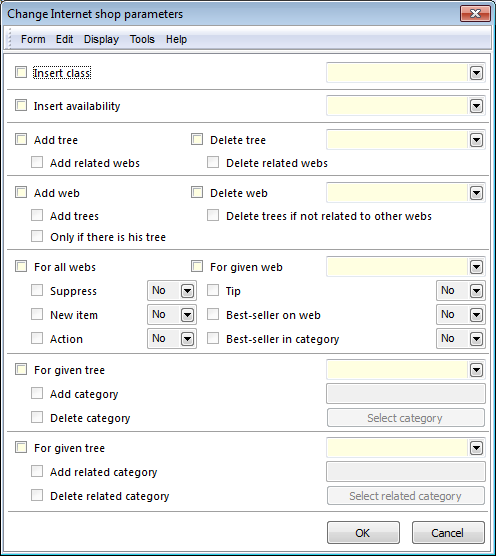
Picture: Change Internet shop parameters
Bulk actions for the internet shop ES (ES page) work just like bulk actions of other pages of Article card. They work over the evaluation filter on or over the records indicated by asterisk.
You can change data of ES page of the selected article cards in bulk on the 1st page. Check the fields, which you want to edit. For each of the selected fields, set a value, that you want to have set on a particular articles cards and if it is possible to choose an action, then choose, whether a value should be removed from a card or added on a card.
You can set the defined flags for the particular or for all internet shops on the Flags for i-shops page.
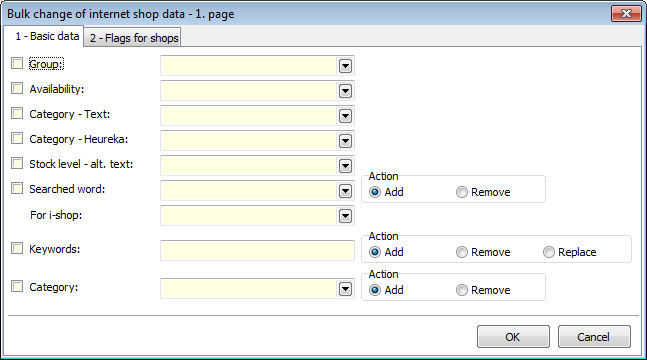
Picture Bulk actions - Internet shop - ES page
Form – Actions
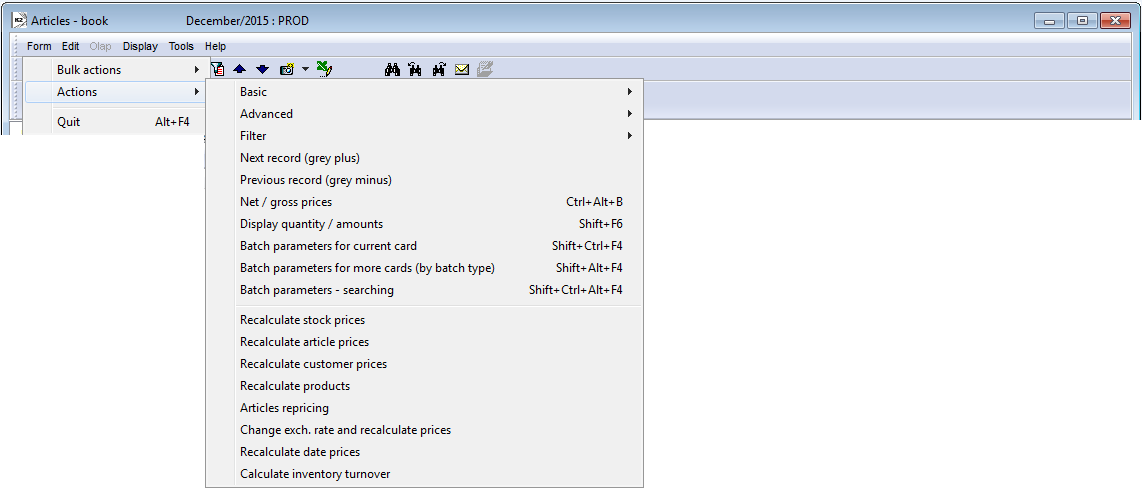
Picture: Form - Actions - Module Menu Functions of Articles
Nett / gross prices |
It affects displaying of Article prices on the 5th page of Article card. For this function you can use the Ctrl+Alt+B keys combination. |
Recalculate stock prices
The function serves for updating the planning stock price on the 2nd page of the Articles card. You can run a recalculation either over a specific article or over the article filter.

Picture: Recalculate stock prices form
Fields Description:
Last price, Add incidental costs |
Last price from the 2nd page of an Article card will be added into the planning stock price. If the Add incidental costs option is activated at the same time, then the last Incidental cost from the purchase item ("CFLastCosts" field in the Article) are also added. |
Sliding price, |
The appropriate price from the 2nd page of an Article card will be added into the planning stock price. |
Price of optimal supplier |
Price from the supplier price list of the optimal supplier (price list for the given article on the 5th page of the appropriate Suppl./Cust.card, espec. price list on the 4th page of Article card for the optimal supplier) is added into planned stock price. |
Price of opt. suppl. (rebate-adjusted) |
Net price from the supplier price list of the optimal supplier (price adjusted by multipliers) is added into planned stock price. |
Purchase cost |
Purchase cost from the 2nd page of Article card are also added to the selected price. |
Supply also zero price |
Required price will be supplied into a pl. stock price, even if it is zero. |
Create date prices |
It creates or updates date selling prices. In the case, that the date selling price already exists, stock price in the definition of this price will be recalculated. In the case, when the date price does not exist, it will be created. The selling price remains unchanged. If this option is activated, then stock price on the 2nd page of article card is not recalculated. |
Recalculate article prices
It offers updating of the article prices that means of the purchase prices, selling prices, price groups and customer prices. The Function is activated either over an Article card (that means do not over a Book) or over the Article filter. Recalculating is related to purchase price and selling price.
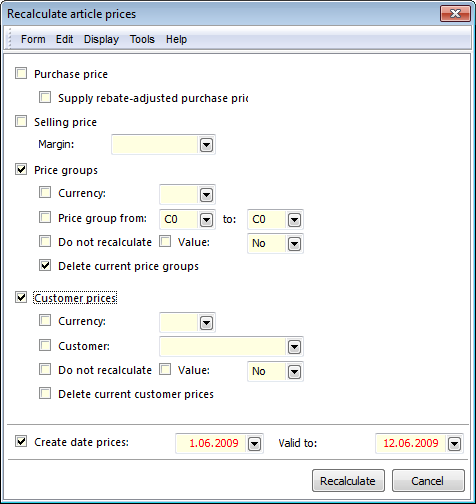
Picture: Recalculate article prices form
Fields Description:
Purchase price |
It recalculates the purchase price on the 2nd page of Article card according to the price of optimal supplier. If in the card the currency is saved, the first found price that is defined in the same currency will enter. If this price does not exist, a price in a basic currency or a first founded price will enter. |
|
Supply rebate-adjusted purchase price |
It recalculates the purchase price on the 2nd page of Article card according to the price of optimal supplier that is edited about multipliers. The Purchase price field has to be checked. |
|
Selling price |
It recalculates the selling price on the 5th page of Article card either according to a selected margin or according to margin that is set on 5th page of Article card. However it does not recalculate the prices of individual group prices and customer prices. |
|
Margin |
The selling price will be recalculated according to this margin. This margin is not entered into the price, only the value will be calculated according to this margin. |
|
Price groups |
Either the prices of selected price groups (if the Price group from - to field is checked in this form) or the prices of all price groups (if the Price group from - to field is not checked in this form) will be recalculated. The customer price will not be recalculated. If any of following fields is checked, only these price groups will be recalculated whose values match the specified values. |
|
|
Currency |
These price groups will be recalculated that are set in the a defined currency. |
|
Price group from - to |
You select the interval of price groups of which the price recalculation will concern. |
|
Do not recalculate |
By checking of this field the prices that has checked the Do not recalculate field in the Article prices form will be recalculated. All recalculated prices will have set this field according to the definition in a Product group. If you check the field Value in addition, then each new recalculated price will have checked the Do not recalculate field according to the value that is selected in a code list. |
|
Delete current price groups |
Before you run recalculation the prices for price groups from the bottom of the 5th page of the Article card will be deleted. If the field is not checked, the prices that should have loaded according to the current (recalculated) definition will overwrite. The prices that are not replaceable remain unchanged - they will be against the definition in addition. |
Customer prices |
The customer prices will be recalculated. If the customer price proceed from a certain price group, you have to check the Price groups field. |
|
|
Do not recalculate |
The meaning is analogous as for the price groups, i. e. as a definition if the records with checked the Do not recalculate field and respectively which value should be set in the new prices. |
|
Customer Currency |
Only the records that are in accordance with the entered values will recalculate in these fields. |
|
Delete current customer prices |
The actual customer prices will be deleted that means all prices related to customers in the bottom of the 5th page of the Article card. |
Create data prices |
A data price will be counted - its Selling price, Price groups or Customer prices. If the Date from and Date to is identical with any price that is already created, its values will change. If any of the data (From or To) is different, a new data price is created. |
|
Recalculate customer prices
The function is activated for one Article card (that means for different than 0th page) or for the Articles filter and it recalculates prices of the selected customer according to the defined parameters.
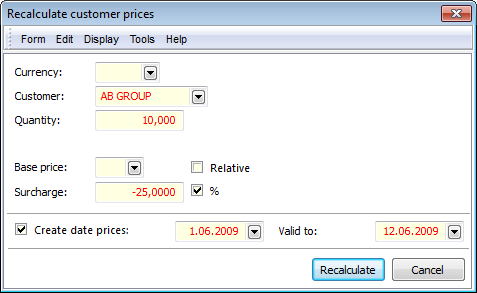
Picture: Recalculate customer prices form
Fields Description:
Currency |
You select the currency if you want the defined customer price in a different currency as well. |
Customer |
You define the customer whose prices you want to recalculate. |
Quantity |
You define the quantity to which the recalculation will relate to. If you set a different quantity than is in the defined customer prices, a new customer price will be created. |
Base price |
You select a price group from which it will be proceeded when recalculating. If you not enter a price group, it will be proceeded from a basic selling price on 5th page of an Article card. |
Relative |
If you check this field, the field Relative in the Article prices form will be checked after recalculation. |
Surcharge |
You enter the surcharge absolutely or as percentage (if you check the % field). |
Create data prices |
A data price will be counted - its Selling price, Price groups or Customer prices. If the Date from and Date to is identical with any price that is already created, its values will change. If any of the data (From or To) is different, a new data price is created. |
Recalculate products
The function is activated either over one Article card, over cards indicated by asterisk or over the products and semi-finished products filter and it serves for calculation of planned stock price, selling price or the weight according to a selected costing model.
- Activating over the cards filter: only routings of the cards, that are in the filter, are gone through, that means if the product contains a semi-finished product, then a routing of this semi-finished product is gone throw only if this semi-finished product is in the filter too.
- Activating over one card or over the cards indicated by asterisks: in this case, going through all levels of a routing (it means all semi-finished products without the need to add them into a filter) can be ensured by activating the Go through all levels option. The function will fill all inferior products/semi-finished products (according to the setting of Article categories) into a queue of the cards for a processing and will process these products without affecting a potential existing filter.
If any level of a production tree is no more recalculated, then, if no specific variant is stated in an item of semi-finished product of a superior product, it will use the data from a card of an appropriate semi-finished product. If a variant is stated, then the current data from the variant (it valids for a calculation of a stock price and weight).
Recalculation does not recalculate the invalidated routing variants. If a recalculation meets with such a variant, then it is written to the error log of the recalculation. Then a product/semi-finished product is appraised in the calculation by a current price of an invalidated variant.
Note: Recalculation goes throw the cards sorted according to the Abbr 1 field till all the cards will value correctly. That means if any semi-finished product will be praised after a product, the recalculation of this product card will run again. That is why it is recommended to have named the product cards and semi-finished product cards by this way that these semi-finished products that are generally on the lowest levels of produced trees were alphabetically according to the Abbr 1 field. You provide the faster the recalculation process.
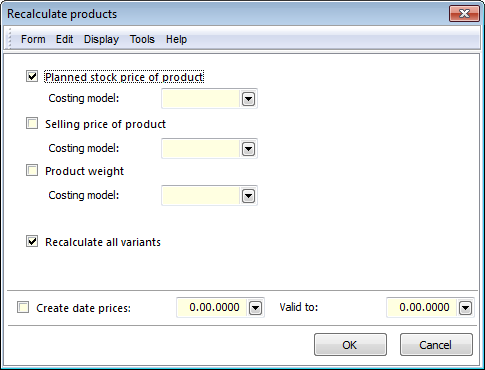
Picture: The Recalculate products form
Fields Description:
Planed stock price of product |
According to the selected costing model, it appreciates the default routing variants of recalculated products/semi-finished products. It enters the price into Pl. stk. price / UM field on the 1st page of variant. If the Recalculate all variants option is activated in the form, then it recalculates stock price in all routing variants. Price of the default routing is also added into Pl. stock price field on the 2nd page of Article card. If calculation lot is defined in the routing variant (filled Calc. lot field), then this quantity is taken into consideration for the calculation of unit planned price. Example: Routing is defined for amount of 1 pc of a product. It contains materials in the value of 10,000 GBP and overheads independent on the produced quantity in the value of 1,000 GBP. The unit planned price is 11,000 GBP. If batches are produced by 5 pcs (the calculation lot), then the planned stock price for one product is 10,200 GBP (10,000 GBP x 5 pcs + 1,000 GBP overheads / 5). |
Selling price of product |
According to the selected costing model, the selling price will be counted from selling prices of items of the default routing and it will be entered to the 5th page of Article card in so called current price (price where the date is defined in "0.00.0000" format ). |
Product weight |
According to the selected costing model, it counted the weight of the default routing variant of the recalculated products/semi-finished products. Weight will be entered into the Weight / UM field on the 1st page of the variant. If the Recalculate all variants option is simultaneously activated, then it recalculates the weight in all routing variants. Weight from the default routing is also entered into the Net weight (kg) field for the basic stock unit of an Article. |
Costing model |
The selection of a costing model according to which the final value will be calculated. If you do not define a costing model, the recalculation will run according to a costing model that is defined on the Article category card (for a stock and selling price according to CM - planned; for a weight according to the CM - weight). |
Recalculate all variants |
If this option is marked, all routing variants will be recalculated and appropriate values will be entered in these routing variants, in a case of Recalculate planned stock price and Recalculate a product weight. Function does not recalculate variants, which are invalid or blocked for the selection. |
Go through all levels |
Option can be activated when running recalculation over one article card or over the cards indicated by asterisks. Active option ensures a recalculate of all production tree levels - further description above in an introduction of description for this function.
|
Create data prices |
If the Selling price of product option is activated, it will create and load a date selling price for the recalculated products. From the loaded items, only a date price with a validity from-to, which is identical with the creating date price for a product, is taken account. If the Date from and Date to are consistent with some price that already exists, the price is only recalculated. If any of the data (From or To) is different, a new data price is created. |
Articles repricing
The function is activated either over an Article card (that means different from 0th page) or over an Article filter and it serves for repricing (recalculation) of Contractor prices, Purchase prices, Selling prices, Price groups and Customer prices based on an entered surcharge. Here you can create the data prices too. The prices can be rounded according to a defined order and constant.
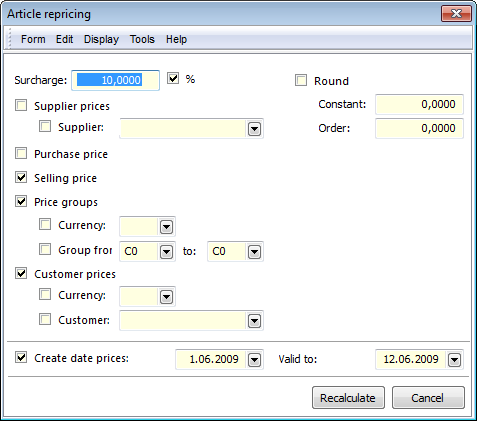
Picture: Article repricing form
Note: The meaning of each field corresponds to the fields in the other forms for recalculations.
Change exch. rate and recalculate prices
This function enables to change purchase and selling prices of an article which prices are defined in a selected currency (article that is used for praising by a different currency remains in the original prices) according to a defined rate. The function is activated over an Article card (that means different from 0th page) or over the Article filter.
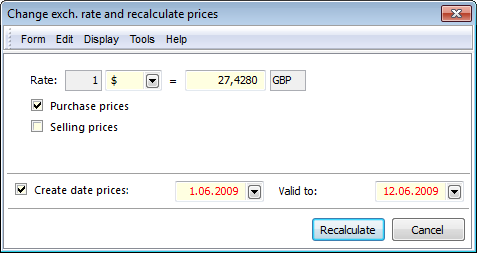
Picture: Change exch. rate and recalculate prices form
By checking the Purchase prices or Selling prices fields the function recalculates the prices in the basic currency according to a rate that is defined in the Change exch. rate and recalculate prices form. If the fields are not checked, only a rate will be recalculated.
Recalculate data prices
The function enables to recalculate the current prices to the data prices and the data prices to the current prices. If you copy from the data prices to the current prices (ie. common), you can check the fields that should have been copied by the recalculation to the price. Further you can edit the data of existing data actions or delete data prices in a selected interval.
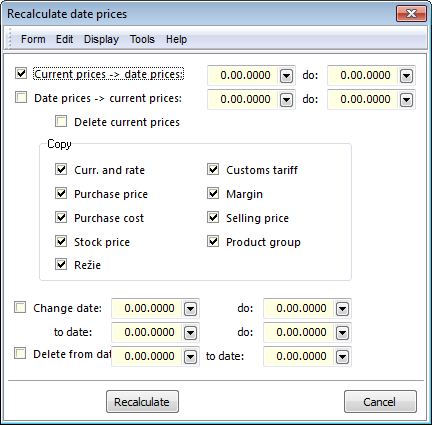
Picture: Recalculate data prices form
Fields Description:
Current prices - date prices |
It serves for recalculation of a date price according to a current (common) price. In this field you enter a data price that you want to recalculate (both dates have to be identical), respectively that you want to create (If at least one date will be different from the existing date price). |
Date prices - current prices |
It serves for recalculation of a current price according to an entered date price. If this variant is used, the options Delete current prices and the fields in the Copy section have a relevance. |
Delete current prices |
When recalculating the date prices to the current prices (i. e. the field Date prices -> current prices is checked) the current price groups will be deleted and substituted with date price groups. |
Copy |
You can define which items should be copied when recalculating of prices. Note: It is valid for a recalculation of the date prices to the current prices only! |
Change date to date |
It serves for change of Date from and Date to of the date prices. That means that you can change all date of a date action by this way. |
Delete from date to date |
It enables to delete date prices that are valid in a defined interval. |
Calculate inventory turnover
It opens the form for calculation of inventory turnover. The further description is stated in the Basic Code Lists and Supporting Modules K2 / Articles / Article card / Evaluation / Inventory turnover part.
Reports of Article
Articles price list
Process No.: CIS008, ZAK007 |
Report ID: SCIS017 |
File: ZB_CEN01.AM |
|
Report description: Articles price list. |
|||
Address in the tree: [Sale/Processing of sale orders] [Basic data] [Prices] [Price lists] |
|||
Report parameters:
DisplZer - Yes Yes - display as zero. |
ShowDealCat - Yes Yes - price groups will display. |
ShowInEuro - No Yes - conversion to EUR according to current rate will display. |
ShowNonArticle - Yes Yes - item other than goods will display too. |
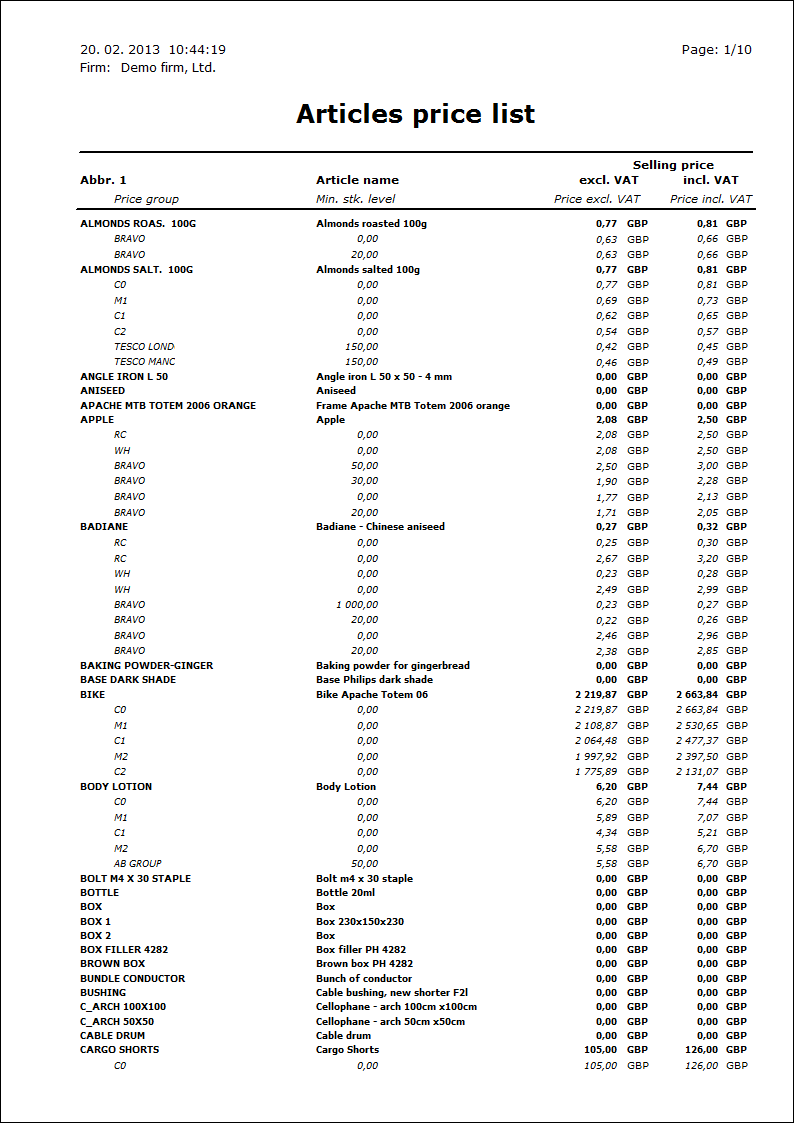
Article catalogue
Process No.: CIS007 |
Report ID: SCIS056 |
File: ARTICLEPICT.AM |
|
Report description: An article catalogue with information about a price, quantity in a stock and an ordered quantity. The displayed price corresponds to the current selling price for a price group or for a customer according to the setting of the Price group, Firm and Currency field in the bottom panel in the Articles book. (Price can be displayed in the Price group column ("CFDealC")). If the article has got an image preview, picture of the article will be also displayed. |
|||
Address in the tree: [Sale/Processing of sales order] [Basic data] [Articles] [Lists of articles] |
|||
Report parameters:
ConclusionText Text at the end of report. |
HideDescription - No Yes - it hides a text above the picture. |
MainTitle The main title of report. |
PictureFolder - PICTK2 Picture type. |
ShowAmount - Yes Yes - it displays current quantity in a stock. |
ShowOrder - Yes Yes - it displays current ordered quantity. |
ShowPrice - Yes Yes - it displays information about a selling price. No - it does not display a selling price of an article. |
SubTitle Text under the main title. |
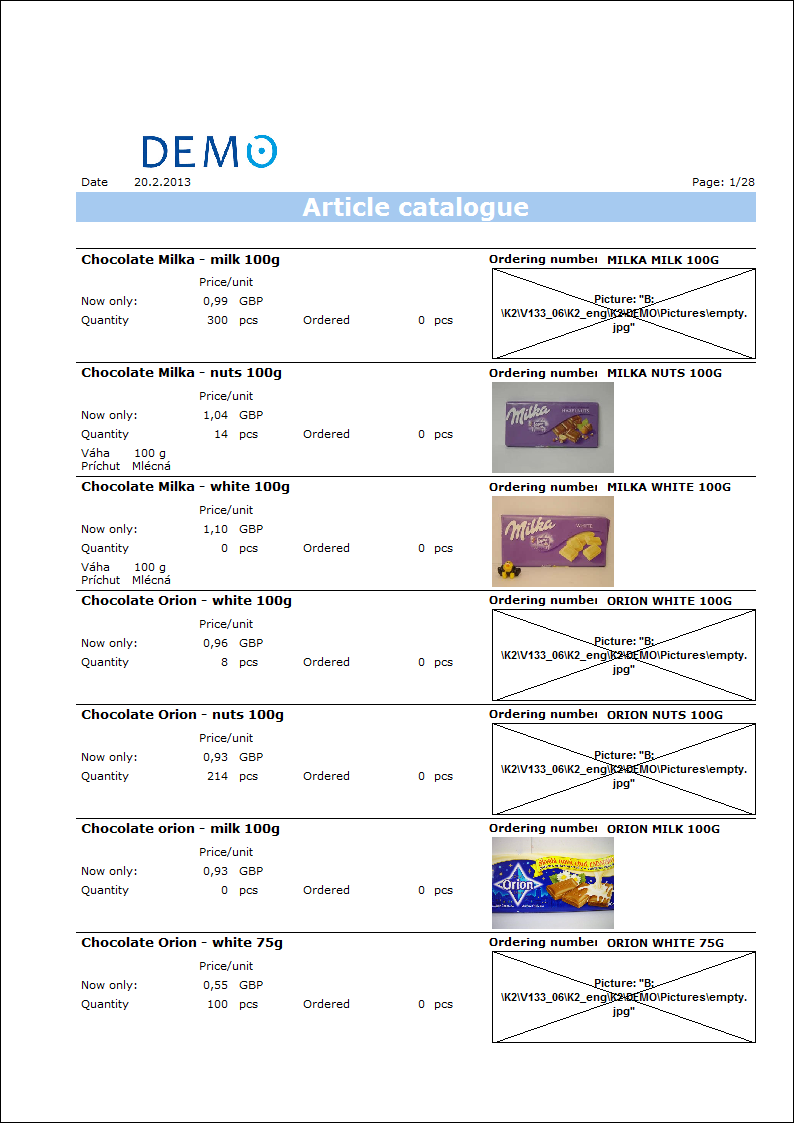
Turnover of articles
Process No.: CIS007 |
Report ID: SCIS028 |
File: ZB_SKE09.AM |
Report description: Articles turnover for the selected time interval. Output can be printed in prices or in quantity. Internal turnovers (transfers within one warehouse or between warehouses of one summary warehouse during processing over summary warehouse) are not loaded. |
||
Address in the tree: [Sale/Processing of sale orders] [Basic data] [Articles] [Stock levels] [Purchase/Processing of purchase orders] [Basic data] [Articles] [Stock levels] |
||
Report parameters:
OtherUnit - ' ' Abbreviation of stock unit for evaluation. Parameter is important only if the value of "UnitType" parameter is set on 5. If Article card has not this unit, it is evaluated in basic unit. |
ShowBatches - No Yes - turnovers of batches will display. |
Show_prices - No Yes - data in prices will be displayed; No - data in the quantity will be displayed. |
ShowZeroItem - No Yes - goods with zero turnover will display. Note: Cards with zero turnover and zero opening level are never printed. |
UnitType - -1 Type of stock unit for evaluation. It corresponds to Unit code list on the 0th page of Articles book (the bottom panel). Default value "-1" means processing according to the setting in Article card. |
